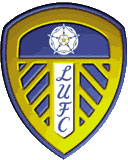 |
 |
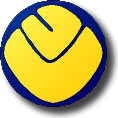 |
Leeds United have sported some distinctive kits down the years, especially
in the days before Don Revie, and here's a pictorial history of the various
colours, sponsorships and badges that have been associated with the club
and its precursor, Leeds City. The March 2006 edition of the Leeds Leeds Leeds magazine carried
a feature on United fan Paul Waite as he prepared to sell his collection
of 52 Leeds tops. The collection included a full set of every shirt - home and away - from
1975 to 2005 and was supplemented with reproduction shirts from earlier
years as supplied by The Old Fashioned Football Shirts Company (TOFFS).
Paul's the sort of compulsive follower that Leeds United have been notorious
for down the years. Paul Waite: 'Since around 2000, I've always liked to mess around on eBay.
Pretty soon I got to buying one or two a month and it wasn't long before
I realised that I nearly had a full set. At that point I wrote to Leeds
Leeds Leeds to ask how I could get a yellow lace up collar Thistle
Hotels one from 1995/96 as they had never gone on sale. They asked Sean
Hardy, the kit man, and the answer was, basically, no chance! But on eBay
again I managed to get a Rob Bowman match worn one for £170! 'I suppose the best one for me is the one with the blue and yellow hoops
- you know the one I mean? Think of Brian Deane! It's classic! I also
liked the yellow one we wore in the Nou Camp when we beat Stuttgart in
the European Cup play off match in 1992 - the one with the weird blue
pattern on the shoulder. The yellow on blue version looked like you'd
been sick on it, but blue on yellow looked great!' In an attention-grabbing effort to get a team of journeymen and promising
youngsters to aspire to higher things, manager Don Revie famously changed
the Leeds look in the early 1960s to a pristine all white, mimicking the
strip of the all-conquering Real Madrid team. Prior to that, the playing
kits of both Leeds City and United had been in various combinations of
blue and gold, as incorporated in the heraldic Leeds city crest, dating
from 1893 when Leeds became a city by Royal Charter. Remarkably, the white
has stuck ever since Revie's original gamble. From 1976 onwards, the all white has generally been punctuated by trim
and edgings of blue and gold; the away kit has used the same colours in
varying combinations, though for a time red was used sporadically. That
never gained favour with the Elland Road public, for whom the colour was
always inextricably linked with the much-despised Manchester United. There
were even complaints in the late 90s because the Packard Bell logo was
primarily red! It was partly to do with the blue and gold, but mainly because of the
association with the nearby Old Peacock Inn, that Leeds City came by their
original nickname of the Peacocks, Though the Football Association was formed in 1863 and introduced the
first rules of the game shortly afterwards, it was some time later before
strictly uniform kits and colours arrived; teams were often clad in a
hotchpotch of whatever gear was lying around. The young men involved in
'Socker' at the time were preoccupied more with their individual look
and style than appearing as part of a single, coherent entirety. Hunter Davies from Boots, Balls and Haircuts: 'Looking at the
photos of the amateur teams in the early years, you see a certain swagger
and swank as they stand in their pristine jerseys and knickerbockers,
trying hard to be individuals, striking personal poses, some lounging
at the front, others sitting sideways. The captain was usually very easy
to spot, looking captain-like, aloof from the team. 'With the coming of the professionals, a uniform, regimental team photograph
soon took over. There was a period when some teams lined up in the goalmouth
for their team shot, in a straight line, but this didn't last long, and
from about 1905 onwards the standard team photo was established, with
two rows of players with the captain in the middle of the front row, holding
the ball. It continues to this day. You see players automatically grouping
themselves, without being asked, having seen photographs of football teams
in the same formation. 'Players were always interested in clothes, judging by a paragraph in
the Chelsea programme from 1907. "A display of caps in shop windows
exercises the same fascination over football players as the milliner's
latest styles do over their sisters, cousins and wives." 'In that same programme there is a witty reference to the latest styles
on the pitch, with players starting to wear shorter shorts. In describing
one player showing a lot of naked flesh, they said 'it was about a shilling
cab fare from the top of his stockings to the nearest portion of his nether
garments."' Recognisable team strips started to emerge after the introduction of
the FA Cup in 1871. Dave Moor from Historicalkits.co.uk: 'Colours were
often those of the public schools and sports clubs with which the game
was associated: Blackburn Rovers first wore the green and white of Charterhouse
School, while Reading first played in the salmon pink, pale blue and claret
colours of the rowing club that spawned them. Colours were changed frequently,
depending on what local suppliers could provide and the players could
afford. The game was played almost exclusively by middle class men who
could afford to buy a shirt in their club's colours. That said, plain
white shirts were the most popular kit of the period, being both relatively
cheap and easily obtainable. 'During the 1880's the balance of power shifted decisively from the middle
class clubs of the South towards the industrial heartlands of the Midlands
and North West. Rows over broken time 'After 1885, the expense of buying playing kits for those who turned
professional fell on the club rather than the players. Secretary managers
with an eye for the accounts naturally preferred to spend as little as
possible, leading to a trend towards simpler kits in basic colours. 'Stockings did not form part of the kit until the turn of the century
while players wore heavy shin guards outside their socks. 'By the close of the century most of the leading clubs were wearing strips
that would be recognisable today. 'By 1901, the regulations that required footballers to cover their knees
were relaxed and shorts (known as "knickerbockers" or "knickers")
became shorter. Shirts and shorts were close fitting and made from tough,
heavyweight, natural fibres. For the first time, stockings became part
of clubs' strips. These were initially self-coloured but quickly design
features such as contrasting rings on the turnover began to appear. The
main stocking colour was always dark (red, blue, black or dark blue);
pale colours did not appear for another 50 years. 'Knickers were only available in white, black or navy blue. It was exceedingly
rare for clubs to wear matching shirts and shorts although Swansea have
always worn all-white. 'Shirts with laced crew necks became popular but a variety of collar
designs were evident. Striped shirts were popular and the trend was for
stripes to become wider than they had been during the previous century.
Striped jerseys tend to make the wearer seem taller while hoops emphasise
the wearer's bulk. This seems to be the reason why Rugby teams favour
hoops while soccer clubs prefer vertical stripes.' It is reported that, when Royal Arsenal became the first southern club
to be elected to the Football League in 1893, 'their shorts cost 3s 3d,
their flannelette shirts 2s 5d and their russet calf boots 8s 6d'. Leeds City Association Football Club was formed in 1904 and entered the
Second Division of the Football League a year later sporting a kit consisting
of dark blue shirts with old gold trim, white shorts and blue socks. The
shirts also bore the club's badge, the city's crest with its distinctive
three owls. Following the appointment of Frank Scott-Walford as manager in 1908,
the City shirt was redesigned to incorporate a rather ostentatious, old
gold pinstripe. A year later there was a reworking of the theme with the
stripes in the top being swapped, making for a rather gaudier look. That
City kit was one of the more distinctive around at the time, but was abandoned
after a short period, probably on the grounds that it was simply too fussy. In the summer of 1910, City signed five young and inexperienced Irish
players and, as the Leeds Mercury reported, on 5 September 1910,
'It must be remembered that these Irishmen After City were forced to apply for re-election to the Football League
in 1912, Scott-Walford was replaced as manager by Herbert Chapman. The
soon to be celebrated Chapman brought fresh hope to Elland Road with a
vow that he would bring top flight football to Leeds. He came very close
to doing so in the years before World War One, when Leeds City introduced
another new look. Their new shirts were still principally dark blue, but
were now hooped by a distinctive, wide gold band. The hoop was replaced
shortly afterwards with a broad gold V on the chest, a design that remained
in situ until City's untimely demise. During World War I, Leeds City enjoyed noteworthy success in unofficial
competitions, but their financial dealings were the subject of later inquiry
by the football authorities. The Leeds City club was wound
up in ignominy in October 1919 with all their players disposed of
via auction. Burslem Port Vale eagerly assumed Leeds' place in Division Two, but there
was soon another professional outfit formed in the city: Leeds United
Association Football Club was admitted to the Football League in 1920. A driving With the resumption of Football League activity in 1919 came a rapid
expansion in membership numbers. Both the First and Second Divisions were
extended from 20 to 22 clubs. The following year, the First Division of
the Southern League was annexed into the League as an embryonic Division
Three. Another twelve months brought the introduction of a Northern Section
of the Third Division, populated with major non-League outfits from the
North. With the rapidly escalating number of professional clubs, the Twenties
saw a massive diversity in colours and combinations, though there was
little in the way of design innovation. In 1934, United ditched their blue and white stripes in favour of blue
and gold halved shirts incorporating the city crest badge; the shorts
were white and socks blue with gold tops. The kit was worn for the first
time on 22 September as United lost 3-0 at Elland Road to Liverpool. In 1939, the Football League Management Committee made the numbering
of players' shirts mandatory. The introduction of numbers was largely down to the visionary Herbert
Chapman. He argued that they would make it easier for players to know
where they were on the field in relation to their team mates. The use of shirt numbers dates back to August 25 1928 when Arsenal wore
them in a 3-2 defeat at Sheffield Wednesday. The system deployed by Chapman
for the game was slightly different from the one that was to be accepted
years later, with the home team taking numbers 1-11 and the away team
wearing 12-22. The concept of numbered shirts had first been mooted back
in 1906, but had been rejected by the game's lawmakers, who continued
to resist it. The Football League were not impressed by the experiment, ordering Chapman
to drop his plans. The Football League Management Committee rejected numbered shirts again
at its 1934 general meeting, but on June 5 1939 the Committee finally
bowed to the inevitable. They agreed a system with both teams wearing
numbers 1-11, each representing a particular position in the classic WM
formation. Numbering was mandated for the 1939/40 season, but only three
games later Britain went to war and the League programme was suspended.
It was another six years before numbered shirts finally became a permanent
feature of League football. Dave Moor: 'Stripes began to appear on the side of shorts for the first
time towards the end of the decade. Shirts and shorts became more generously
cut, giving rise to the baggy shorts reaching to the knee so fondly remembered
on shorter players … Clothing rationing limited the ability of clubs to
replace their kits and several were forced to change from their traditional
colours to those that they could purchase with ration coupons. Southport
FC turned out for several seasons in green and white hoops, a gift from
one of the club's directors made during the war. Laced crew necks all
but disappeared aside from a few diehard, traditionalist clubs, in favour
of collared shirts. Hooped stockings became extremely popular. During
the early Fifties most clubs stuck to their traditional designs with only
minor alterations to shirt and stocking trims.' The eccentric Major Frank Buckley became Leeds United manager in the
spring of 1948 with the club back in the Second Division. He was convinced
that the players were performing poorly because the halved shirts made
it difficult for them to pick each other out. Former player Jim Bullions
recalled that the Major organised a practice match in October 1948 with
one side in club colours and the other sporting plain shirts. Chairman
Sam Bolton and director Percy Woodward watched from the sidelines and
were persuaded by Buckley to invest in a new strip. United switched to old gold shirts finished with blue sleeves and collars,
white shorts and black, blue and gold hooped stockings. Black shorts replaced
the white ones in August 1950 on the grounds of improved visibility. At
the start of 1955/56 came another change, to royal blue shirts with gold
collars, white shorts and blue and gold hooped stockings, a kit that echoed
that worn originally by Leeds City. The change was lucky and Leeds won
promotion at the end of the season. They were still wearing the same kit
when they were relegated four years later under the management of Jack
Taylor. Dave Moor: 'Continental influences were seen in new lightweight strips
that began to appear in 1955, featuring bold V-necks, short sleeves and
more streamlined shorts. There were several innovations in design, perhaps
most notably the "candy stripes" first worn as change strips
by Manchester City and Aston Villa in successive FA Cup finals (1956 and
1957 respectively). This design enjoyed a vogue that lasted until the
mid Sixties. By the end of the Fifties the heavy playing kits and boots
of previous eras had disappeared. 'Beginning around 1960, crew necks started to replace V-necks. Shirts
became ever tighter, shorts became very short indeed and stockings were
lightweight. Don Revie took over as Leeds United player manager in the spring of 1961
and went for a drastic colour change for the start of the 1961/62 season,
introducing a plain all-white throughout. United teams remained in the
pristine strips until 1976, though many argued that the saintly purity
of the kit was in stark contrast to the roughhouse onfield antics the
manager employed. The only changes over Revie's time came with subtle
modifications to badge, logo and collars. Bagchi and Rogerson: 'Though [Revie's} decision effectively jettisoned
forty years of United's history, astonishingly little was made of it at
the time. The replacement colours were to be all white, in quite deliberate
imitation of the famous all white of the finest team in the world, Real
Madrid. To re-profile a club so efficiently on such a whim demonstrated
the man's flair and vision, drawing a line under the failures of the past.
That nobody remonstrated with him for it is an early sign of the Board's
growing willingness to indulge him and of the interminable apathy of the
majority of Leeds fans. Such a flagrant psychological gimmick was risky.
If he pulled it off, it would be interpreted as a masterstroke. If "New
Leeds" continued to founder, however, it could look like hubris and
finish his career. To invite comparisons with Gento, Di Stefano and Puskas
when all he had was McConnell, Peyton and Cameron ... one has to admire
Revie's nerve.' The white had been tried temporarily some time before, as recorded by
Andrew Mourant: 'Early in 1960/61, spectators were given a glimpse of
the future - for the home game against Middlesbrough on 17 September 1960,
the team appeared in what was basically an all white strip, though with
blue and gold trimmings, instead of the blue shirts, white shorts and
blue and gold socks. '[Revie's] famous decision … showed the touch of a man with a dream,
an ideal that his debt-ridden, down-at-heel club might one day emulate
the feats of one of Europe's richest and most brilliantly successful teams.
The move invited astonishment among some, ridicule from others. While
Revie himself felt the club had not a cat in hell's chance of reaching
such heights, he was determined to try anything to get players believing
in themselves. And along with the new kit, Revie decreed that on away
trips, players should no longer slum it in third-rate hotels but stay
in the best establishments money could buy.' Jack Charlton claimed that there was pragmatism behind the change: "This
was the gear Real Madrid played in and the initial reaction from the local
press was that Revie was aping the Spaniards. Not so, explained Don. In
his opinion, white is the easiest colour to identify on a pitch. When
you have only a split second to make a pass before the tackle comes in,
you're more likely to pick up the right man if he's wearing not red or
blue or green but white." Charlton borrowed the trick when he took over
as Middlesbrough In 1964, Leeds United introduced a badge to the shirts: a perching owl
on a white background circled by a dark blue border. The design was a
surprise, given the superstitious Revie's morbid misgivings about the
symbolism of birds. The owl came from the city crest, which itself was
based on the crest of Sir John Saville, the first alderman of Leeds in
1931. Andrew Mourant: 'His most famous superstition was his continued wearing
of a "lucky" blue suit, notwithstanding its shabbiness in later
years. But Revie's waking hours were riddled with other phobias and rituals;
taking the same route to his dug out before a match, a fear of ornamental
elephants, a readiness to believe that a gypsy curse on Elland Road was
preventing his side winning, even a distaste for birds on pictures or
as motifs. '[Harry Reynolds' daughter] Margaret Veitch's husband Peter remembers
a visit Revie made to their home in Pudsey shortly after they had done
some decorating. "We wanted to put some pictures up in the bedroom.
The only ones I could get which were small were birds. He wouldn't go
in the bedroom. He said: "What are they doing there... you don't have
birds in your house. You don't have birds anywhere." That's the reason
the owl was eventually taken off the club badge. He wouldn't have birds."' Not too many other top teams wore white shirts in those days - Tottenham
were the only regular example in the top flight until Derby County's promotion
in 1969 - United gradually moved onto change kits of all blue or all red, but then
settled on all yellow, as they famously wore in the 1972 FA Cup semi-inal
against Birmingham City. By then, Revie's misgivings had led to the owl
badge being ditched in favour of the scripted LUFC logo, as modelled for
the first time in the 1971 Fairs Cup triumph over Juventus. Pedantics everywhere (one or two at least!) protested vehemently that
there was a missing 'A' in the logo, because Leeds United's full title
incorporated 'Association Football Club'. I guess it just wouldn't have
looked as nice. The 1971/72 campaign saw the introduction of numbered blue stocking tags;
they embodied the snazzy Super Leeds image that evolved in 1972 after
handsome televised victories over Manchester United and Southampton and
the club's sole FA Cup win. The same kit and gimmicky tags were rather
less lucky for United the following season when they lost an FA Cup final,
a Cup Winners' Cup final and finished third in the league. In 1973, as Revie's parting shot, came the embodiment of Seventies imagery
with the iconic LU Smiley badge. It was a classic PR stunt from Revie,
mingled with tracksuits bearing the players' names and branded footballs
for hurling into the crowd after pre-kick off callisthenics. The manager's
predilection for gimmicks was years ahead of its time and all with the
explicit intention of gaining acceptance from a public outside of West
Yorkshire. 1973/74 brought a record unbeaten run, a spectacular championship
triumph and some wonderful performances. Revie was popularly credited for initiating the football industry's move
to exploit the game's increasing commercial possibilities. He recognised
that passionate football fans would be prepared to pay good money to wear
replicas of the team strips worn by their heroes. The more distinctive
the kit, the more obvious it was who was being supported. Revie arranged
a deal with the new kids on the block, Admiral Sportswear, and for a while
the United strip sported the distinctive Admiral logo, which enjoyed almost
equal billing with the club badge. Revie repeated the trick when he took over the England team in 1974,
though his time as a Football Association employee saw him branded as
a money grabbing, disloyal mercenary. Dave Moor: 'The established manufacturers, Umbro and Bukta, quickly followed
suit and logos began to appear all over the place. Admiral pursued a vigorous
and innovative marketing campaign, targeting the top clubs, radically
redesigning their kits, which would then be showcased at important Cup
finals. Rapidly a market was created. Instead of having to buy three or
four sets of kit each season, leading clubs found that manufacturers were
queuing up to offer free kits and a share of the profits from the sale
of replicas. The new kits had, of course, to be distinctive to be saleable.
When Manchester United adopted an Admiral kit in 1975, the popular press
raised an outcry. Devoted fans now had to shell out £15 for an authentic
United shirt instead of the £5 that would have bought a generic red shirt
with white trim: in the pre-Thatcher era the Daily Mail for one considered
this to be gross exploitation. 'These commercial considerations drove a new wave of innovation in kit
design. It became desirable for clubs to register copyright on their badges
and to feature these on their shirts. Manufacturers competed to produce
new designs that displayed their own logos to best effect. Admiral led
the way and were quickly followed by Umbro and Bukta who all introduced
kits that featured sleeve trim with their distinctive logos. 'Towards the end of the 1970's there was increasing pressure on clubs
to feature sponsors' logos on players' shirts, pressure that was resolutely
resisted by the football and broadcasting authorities. Derby County landed
the first deal with Saab in 1978 but the sponsored shirts were never worn
after the pre-season photo shoot. It fell to Liverpool a year later to
wear the first shirts to carry a sponsor's name in 1979. 'Once Liverpool broke the mould, clubs began to exploit the potential
revenue from selling shirt sponsorship. The BBC and ITV companies refused
to broadcast matches featuring branded shirts, forcing clubs to remove
sponsors' logos when the cameras were present. Coventry City thought they
were on a winner when they introduced a kit that incorporated the logo
of the Talbot car manufacturing company into the design but the TV companies
blackballed them until they introduced an alternate strip for televised
games. 'In 1983 the TV companies finally gave way and allowed sponsored shirts
to be broadcast: immediately the value of a sponsorship deal with a club
that would feature regularly on Match of the Day or the equivalent ITV
programme went through the roof. At the time, Football League regulations
restricted the size of logos to a maximum of 81square centimetres (32
square inches) but for televised games they had to be half this size. 'The monopoly enjoyed by Umbro and Bukta since time immemorial was now
broken as a new breed of kit manufacturers stepped in with sophisticated
new brands. Le Coq Sportif (France), Hummel (Denmark), Adidas (Germany),
Patrick and Hobotts (UK) 'In the 1982 FA Cup Final Tottenham Hotspur unveiled the first shadow
stripe design and suddenly everyone was sporting shadow stripes, pinstripes
or both as technology allowed for ever more intricate designs. 'Towards the end of the decade, shirts became more generously cut as
new lightweight fabrics became available. Improvements in production allowed
for intricate designs to be woven or printed into the fabric itself, permitting
manufacturers to counteract the burgeoning market in cheap counterfeit
kits that began to appear.' Leeds United were as effective as anyone in exploiting commercial possibilities.
The period from 1976 through to 1981 saw the addition of busy blue and
gold trims on collars, sleeves and cuffs, and a couple of variants on
the Smiley badge. In 1981, the club switched kit manufacturers back to
Umbro and introduced a new badge, similar to the last version of the Smiley
but with a stylised peacock, after the club's original nickname, replacing
the LU. It remained in place until 1984, when a new club badge was introduced.
That lasted right through until 1998, making it the longest lived of the
modern era. The Rose and Ball badge was distinctive, in the traditional
blue, gold and white and incorporating the white rose of Yorkshire together
with the club name. Relegation in the summer of 1982 brought financial hardship for Leeds
United and a desperate scrabble for any funding that was available The club's first sponsors, lasting just twelve months, were RFW (RF Winders),
a company from Pudsey. Over the next three years United ran through three
different patrons: Systime, WGK and Lion Cabinets. They then agreed a
five-year deal, beginning in 1986, with local clothiers, the Burton Group.
Future United chairman Peter Ridsdale was managing director of Burton's
Top Man chain at the time and was the moving power behind the association,
joining the United board in 1987. 1989-91 - Burton insisted that their Top Man brand be used for
the remaining two years of their association and 1989/90 saw the logo
introduced on a redesigned strip with a round, button up blue collar,
with blue and gold trimmings added to shirt and socks. The new image brought
luck as the period saw the club capture the Second Division title and
fourth place in the top division. The away kit sported a rather busy pattern
of yellow and amber triangles, with broad blue and white panels down the
side of the shorts. 1991/92 - The same kits were in place for United's league championship
year, though there was a change of sponsor. The Burton deal ended, and
the club announced a multi-million pound deal with Admiral Sportswear;
it was said that the arrangement would last for five years, but would
not commence until 1992. The club had to find an alternative and managed
to agree a stop gap association with the Yorkshire Evening Post
to cover the twelve-month period. The newspaper group certainly got its
money's worth with the return of the championship to Elland Road after
18 years. 1992/93 - The new Admiral kit was only marginally different from
the previous design, though it did incorporate a new V-neck look, but
the change strip underwent a more radical transformation. The initial
choice was a predominantly blue affair with an unsightly yellow-flecked
pattern on the shoulder. It was the first time that the club had moved
away from yellow for an age, but a yellow variant with blue flecking was
soon introduced because of potential colour clashes. It was the Admiral
gear that bedecked the team as the club resumed its place in European
competition and captured the Charity Shield. 1993-95 - Within twelve months of the commencement of the Admiral
deal, there was a falling out and the two organisations parted company
after a legal dispute. United established a new arrangement with the global
Asics firm for the supply of its kit, while the Thistle Hotels chain became
sponsors for three years. A completely new look was introduced with a
blue and gold hoop across the chest and blue collar and cuffs. The change
shirts were of blue and gold stripes, coupled with blue shorts and yellow
socks; for a number of games the blue shorts and yellow socks were combined
with the home shirts. The blue and gold stripes resulted in a number of
colour clashes and, in early 1994, dark blue and green striped shirts
were introduced. 1993 also saw the onset of squad numbering and players' names on shirts.
The system was used for the first time in the League Cup final, on April
18 when Arsenal met Sheffield Wednesday. Less than a month later, squad
numbers were used by the same two teams as they reconvened at Wembley
to contest the 1993 FA Cup Final, and then again five days later for the
replay. Squad numbers were introduced as standard for the 1993/94 Premiership
season. 1995/96 - A distinctive all white kit was launched, featuring
the return of the LUFC scripted logo, though still incorporating the Thistle
Hotels brand. It represented a stylish recreation of the Seventies look
and was the kit that Tony Yeboah wore during his marvellous 1996-98 - The summer of 1996 brought European Championship football
to Elland Road and new backers in Puma and Packard Bell - London-based
media group Caspian bought the club and introduced George Graham as manager.
Together with the Packard Bell logo, the new kit incorporated a broad
yellow trim. The change kit saw the white and yellow interchanged, while
for 1997/98 the old gold and blue halved shirts of the Thirties and Forties
were revived to spectacular effect. 1998-00 - In keeping with the global branding of the club, 1998
brought an end to the 14-year Rose and Ball period with the introduction
of the shield badge, bringing a modern, almost European, feel. It was
a radical change to what had gone before and it took a while to gain acceptance.
After a year, there was a minor change, with a ball being added at the
centre of the white rose. The home kit was virtually unchanged apart from
the addition of a collar and the heavy usage of the Puma brand down the
sleeves. 1999 brought a new change kit with the powder blue Lazio style
shirt with dark blue trim and shorts. It was a stylish and popular design.
A yellow version was 2000-02 - As United prepared for their UEFA Champions League debut
in 2000, they joined forces with Nike and Bulmers. An almost completely
white kit was introduced. The shirts restored the V-neck look and bore
the Strongbow logo. Peter Ridsdale's European shield was seen throughout
the continent as United made their way to the last four of the Champions
League. The change kit for both seasons was a simple all yellow affair.
A garish blue outfit with bold yellow trimmings was introduced in 2001
as a third option. 2002/03 - David O'Leary and Rio Ferdinand left Elland Road in
the summer and Terry Venables was recruited to preside over a money-strapped
decline. The only change in the home kit saw the introduction of a gimmicky
white collar overlaying a blue V-neck. The brash blue change strip was
retained for a second year, and United wore it when they won at Arsenal
in their penultimate game to avoid relegation. An even more bizarre yellow
and amber look was introduced as the third strip. 2003/04 - The whisky manufacturers Whyte and Mackay began a three-year
2004/05 - A new kit was introduced with blue and yellow flashes
on sleeves, shorts and socks and sponsor's name added to the back of the
shorts. An away strip of powder blue shirts and dark blue shorts, harking
back to the European campaign of 1999/00, was introduced. 2005/06 - Yellow and blue pinstripes brought echoes of the Eighties
when added to the white shirts. The change kit consisted of dark blue
shirts, with sky blue trimmings and shorts. 2006/07 - In July 2006, Leeds United announced a major new deal
with Bet24 on its website: 'Leading internet betting site Bet24 will be
featured on the front of the club's shirts next season, but the agreement
goes far beyond a normal shirt sponsorship deal. Bet24 is 90% owned by
Modern Times Group and the agreement reached between United Chairman Ken
Bates, Holger Kristiansen, the CEO of Bet24, and Jorgen Madsen, CEO of
MTG Denmark, will go a long way towards regaining United's international
standing, with all the commercial and merchandising opportunities that
entails. 'MTG is an international media group with operations in more than 30
countries around the world and is the principal broadcasting business
in these regions. It is the largest free-to-air and pay-TV operator in
the Nordic and Baltic regions and the largest commercial radio operator
in northern Europe. MTG's Viasat TV channels reach 60 million people in
19 countries every day and MTG radio stations reach three million daily
listeners. The company already has major connections with football and
Viasat recently expanded their exclusive rights to show Champions League
matches to the Baltic regions, Finland and Hungary to 2008/09.' The home kit for 2006/07 saw the pinstripes disappear but heavy use of
blue trim, alongside the Bet24 logo. The change strip saw the restoration
of all yellow with blue collar and cuffs. The protracted struggle to exit administration in 2007 after relegation
led to a delay in arrangements for a new sponsor. During the pre-season
win at Darlington, United took to the field in shirts with tape covering
the name of the lapsed sponsor. Eventually Red Kite Holdings, a property
company was revealed as the new sponsors, with the red in their logo infuriating
United fans. For 2007/08, the new Italian supplier, Macron, with whom Leeds
signed a four-year contract, delivered traditional home and third kits
but the new away outfit, in sky-blue and deep navy, was a complete novelty.
Although the kits were formally announced on 10 July, Netflights.com were a local online travel agent, who included Terry Fisher
and former United captain Trevor Cherry in their management. The men came
close to a buy out of United at the time the Gerald Krasner-led consortium
rescued the club in 2004. According to the club's official website: 'Netflights.com stepped in
as a White Knight to rescue Leeds United after contractual difficulties
with the proposed shirt sponsor proved unresolvable. Netflights.com and
Leeds United have successfully signed a three-year commercial agreement.
The deal sees netflights.com becoming the official shirt sponsor of Leeds
United. The two organisations are working together to drive a variety
of co-marketing opportunities during the season with netflights.com appearing
throughout the club's Elland Road stadium, advertising on backdrops during
interviews and advertising in the matchday programme.' 'The agreement was signed by netflights.com's managing director Terry
Fisher and Ken Bates, chairman of United. Commenting on this agreement
Fisher said, "We are delighted to have concluded this commercial
agreement with Leeds United. Travel companies have a great link with football
clubs, as football is truly a worldwide phenomenon and netflights.com
is excited to be working with Leeds United. For me the deal is even sweeter
as I have followed Leeds since I was a small boy and this is a relationship
that will bring mutual benefit to all parties." 'Fisher joined netflights.com just two years ago and has brought in a
whole new management team and driven a return to profit for the business.
Terry as well as being a keen Leeds supporter is also a knowledgeable
football fan boasting the accolade of being the youngest ever football
chairman, championing Huddersfield Town at the tender age of 29. 'Terry isn't the only link to football within the netflights portfolio.
Part of the travel group, Sellers Travel in Huddersfield is run by Trevor
Cherry, ex United skipper who also captained England. Trevor is overjoyed
at being involved with the club again. He is working closely with netflights.com
and Leeds on this collaboration and will be a regualr visitor to Elland
Road throughout the season.' For 2009/10, the netflights.com connection remained in place,
and the new kit was used for the first time in the final League game of
2008/09, at home to Northampton on May 2. The new home kit was an attractive
reinterpretation of their familiar all-white strip with a royal blue flash
down the left hand side, trimmed with gold. Tradition was also maintained
with the all-yellow away kit, which had royal blue side panels to the
shirt and shorts, 'an attractive interpretation of the orthodox second
choice. United chose to launch their 2010/11 kit in time for the final
game of 2009/10, at home to Bristol Rovers, when they finally confirmed
their promotion back to the Championship. It saw a return to the classic
all-white strip that had been synonymous with some of the greatest periods
in United's history. It could not have had a more fitting game in which to make its bow, showcasing
a memorable day for United and their fans with Jermaine Beckford's only
appearance in the kit being one of his best. Bucking the trend of the previous couple of years, when they had unveiled
their new kit in the final game of the previous campaign, United held
back on launching their 2011/12 kit until 7 July. The previous day, club head of media Paul Dews announced that the club
would be releasing news of arrangements shortly, but then photos of the
new home shirt, as modelled by club captain Jonny Howson, started circling
on Twitter and the truth was accidentally confirmed by Lloyd Sam on his
personal Twitter account. Leedsunited.com reported as follows: 'The kit for 2011/12 is a retro
style shirt in white fabric and is influenced by the 1991/92 championship
winning season which the club is celebrating this season. The shirt features
include the shiny fabric and distinctive royal and yellow tipping on the
sleeve. The home kit is launched on Saturday 16 July at 8am from the Elland
Road and Online Superstores exclusively.' Jonny Howson toed the party line: 'The new kit is something the players
always look forward to seeing. All of the lads were wanting a look as
soon as it arrived and you feel like the new season's on the way now.
It's a great shirt and the start of new things.' The Scratching Shed fansite offered the less flattering comment: 'Aside
from the enormous cartoon sponsor on the shoulder and the enormous sponsor
in the middle and the tacky white shiny material they've made it out of,
I think you'll agree this is still one of the worst Leeds United kits
ever. Fingers crossed it's a hoax!' Jagsnorbens tweeted: 'Tell Jonny he needs to shave that bum fluff off.
He looks like a 15-year-old trying to get into Yates'.' Enterprise Insurance were identified as the new main sponsor and United
chief executive Shaun Harvey said, 'We are delighted that we have reached
an agreement with Enterprise Insurance to become the main club sponsor.
It's great to align our brand with a rapidly growing European Insurance
company. There was considerable interest in becoming the main club sponsor
and we believe that the relationship with Enterprise will deliver significant
benefits to the club and our fan base.' Enterprise Insurance managing director Andrew Flowers said. 'We are delighted
to be main sponsor for Leeds United. It's a terrific club with a great
history, The agreement was for an initial one year term and would see all first-team
playing kit, training wear and replica kit branded with the Enterprise
Insurance logo. Adult shirts were priced at £40 and Junior shirts at £36. The kit was used for first time in the first pre-season friendly, a 2-0
victory at Falkirk on 13 July, when the first goal came rather ingloriously
courtesy of Falkirk defender Thomas Scobbie deflecting a cross from Ramon
Nunez past his own keeper after 36 minutes. Rob Snodgrass was the first
Leeds man to score in the new strip 18 minutes later with a header. On 21 July, the club released the details of the new away kit for 2011/12,
with Paddy Kisnorbo and new midfielder Michael Brown modelling the strip
on the leedsunited.com website. The kit was basically all black with a
green pin-stripe in the shirt and fluorescent lemon trim on the shirts,
shorts and socks and the sponsor's logo blazoned across the chest in the
same lemon. On the historicalkits.co.uk website the new second strip was described
as 'black with bright neon yellow trim - a break with tradition and perhaps
one of the most unpleasant strips of the season', while thescratchingshed.com
called it a glow-in-the-dark ensemble, adding, 'The yellow and black colours
Macron have gone with haven't caused too much of a shock as Lloyd Sam
dropped that little bombshell a couple of weeks back. I'd personally assumed
it would be predominantly yellow, however, so the black being the main
colour did surprise me a little. I wish I could find the words to sum
up the following, but I really can't …' However, a poll on the same site,
showed fans split almost straight down the middle between liking it (49%)
and disliking it (40%), with a further 11% undecided. The second change strip was the royal blue outfit launched in 2010/11,
updated with the Enterprise Insurance logo. On 24 April 2012, United announced that Enterprise had extended their
sponsorship agreement for a further two years and would continue to act
as main sponsor until the end of the 2013/14 season. Shaun Harvey said: 'We are delighted ... We have developed an excellent
working relationship with Enterprise Insurance during the course of this
season and have launched a number of Leeds United branded insurance products
through the partnership, including the increasingly popular Leeds United
Insurance Compare website. We look forward to developing our relationship
further with Enterprise and helping them to promote their business to
a worldwide audience.' Commenting on the extension of the sponsorship agreement, Enterprise
Insurance managing director Andrew Flowers said, 'We are delighted to
continue as the main sponsor for Leeds United. It's a terrific club and
over the course of this season we have seen the real benefits of a marketing
partnership with a globally recognised brand such as Leeds United. The
Enterprise brand has been featured in 11 live games on television this
season, generating significant exposure for our company not only in the
UK but Internationally where we have growing business interests.' Three days later came the linked announcement of the new kit for the
2012/13 season, available from 5 May, launched with an Eminem-inspired
video on YouTube, under the banner of 'New Shirt, New Start', with manager
Neil Warnock offering an inspiring rallying cry: 'You've all seen the
stadium, and you know what it's like to play for Leeds, it's an amazing
place, isn't it? You've got to revel in the atmosphere. You know the fans
are absolutely fantastic, aren't they? What can you say about them, they've
been amazing. And if you're good enough, and if you've got enough under
your shirt, and I mean by that have you got the desire, the passion, the
commitment. Because as a manager I need to know who's in the trenches
with me. Forget this season, give me your shirt. Who's ready to wear this?'
It might have been According to the club's official website: 'We are proud to reveal the
new Leeds United Macron home kit and showcase what the team will be wearing
next season. The white shirt will be worn with white shorts and socks,
all of which are on sale from Saturday 5 May ... 'The shirt interprets the club colours in a unique style and has been
designed by Macron, in conjunction with the club, in order to create a
bespoke shirt that integrates a variety of different fabrics. The main
body fabric is framed with a royal blue piping whilst the neck features
a Korean style collar made of ribknit fabric with the year the club was
founded, 1919, embroidered in the back neck along with the club's moto
'Pride of Yorkshire - Agmine in Uno'. Mesh inserts on the side flanks
regulate the body temperature guaranteeing maximum breathability. 'The new Macron 2012/13 home shirt is available in adult sizes small
to 5XL, priced at £40 and junior sizes small junior to XL junior priced
at £36. Adult home shorts are available in sizes small to 3XL and are
priced at £19 with Junior home shorts available in sizes small junior
to XL junior priced at £16. Adult home socks are available in sizes 7-11
and are priced at £10 and Junior home socks are available in sizes 12-2
and 3-6 priced at £8.' With the club still in the midst of secretive discussions about a potential
transfer of ownership and with supporters besides themselves with impatience
at the deafening silence, on 5 July the official website revealed the
away kit that would be used for the following two seasons. New signing Jason Pearce and his prospective centre-back partner Tom
Lees were chosen to model the kit, which was described thus on the website: 'The new kit, which has been designed by Macron in conjunction with the
club combines technology with classic Italian style and presents the new
'azzurro' steel colour (blue). "The shirt was created integrating a range of different fabrics;
the main body is complemented by navy blue flanks in a mesh fabric that
define the profile of the shirt and allow maximum breathability. The neck
comes in ribknit with under collar contrasting fabric and the year the
club was founded, 1919, embroidered on the back. 'The shirt will be on sale at the Elland Road Superstore from 9am on
Thursday 2 August. The new Macron 2013/14 away shirt is available in adult
sizes Small to 5XL, priced at £40 and junior sizes Small Junior to XL
Junior, priced at £36. Adult away shorts are available in sizes Small
to 3XL and are prices at £19 with junior away shorts available in sizes
Small Junior to XL Junior, priced at £16. Adult away socks are available
in sizes 7-11 and are priced at £10 and junior away socks are available
in sizes 12-2 and 3-6, priced at £8. Infant and baby away kits are also
available priced at £32 for infants and £28 for babies.' The initial views about the kit were positive, though there was some
uncertainty about the shorts. Out of a poll of 1,000 visitors to the site,
19% gave it 5 stars, 48% 4, 22% 3, 7% 2 and 4% 1. The Yorkshire Evening
Post's poll saw 65% saying they liked the kit. On 24 April 2013, just four days after United's stay in the Championship
for another season was confirmed with promotion and relegation both mathematically
impossible, came the now customary pre-end-of-season announcement of the
home kit for the forthcoming season. The club's official site announced: 'We are proud to reveal the new Leeds
United Macron home kit that the team will be wearing for the 2013/14
campaign. The white shirt features retro vertical stripes in blue and
yellow which adds a different dimension to the famous white shirt. The
collar is ribbed in royal blue and the shirt has micro mesh side panels
for better movement. The back neck also features an appliquéd Leeds United
rose. The shirt is teamed with white shorts and socks which feature details
taken from the retro stripe on the shirt. The bespoke kit has been designed
by the club and Macron to create a kit unique to Leeds United integrating
various different fabrics. 'As per the current season, the Home Shirt is available in a bodyfit
style, as worn by Leeds United first team. The bodyfit shirt allows freedom
of movement and the jersey weave incorporates elastane which guarantees
regular compression and facilitates movements by adhering to the body. 'The shirt features the logos of Main Club Sponsor, Enterprise Insurance,
By 27 April, the poll on the same site had received around 1500 responses,
with 35% declaring they loved the new kit, 36% hating it and 29% undecided. On 22 July, just a couple of weeks away from the opening day of the 2013/14
season, the club revealed their new away kit, the club's official website
going for dramatic effect under the headline, 'Time To Shine,' and continuing
with 'The wait is over and our golden treasure has been found.' The club had used Twitter over the preceding few days to trail the #LUFCTreasureHunt,
with referring to the fact that the new shirt was largely of a distinctive
gold in colour with 'navy detailing teamed with navy shorts. The collar
of the shirt is a gold and navy rib which is reflected in the socks, completing
the kit which will be worn by the team on their travels over the forthcoming
season. The shirt and shorts feature a tonal navy and gold crest which
can also be seen on the new range of training wear which has already received
a great response from supporters … The shirt features the logos of Main
Club Sponsor, Enterprise Insurance, and brand new Secondary Shirt Sponsor,
Help Link UK.' The change kit was worn for the first time in the pre-season friendly
against FC Nurnberg at Elland Road on 27 July. The German Bundesliga outfit
showed the gulf in class by emerging with an impressive 2-0 victory. Its
first usage in a competitive fixture was on 11 August in the 0-0 draw
away to Leicester City in the Championship. On 5 September, Enterprise Insurance extended their agreement to act
as United's main sponsors, rolling on the original three-year deal for
a further three seasons, through to the end of the 2016/17 campaign, makingt
it the longest deal of its kind in United's history. United managing director David Haigh said: 'The club is delighted to
secure further long-term investment and support from our main sponsor.
We're particularly delighted to see such a long-standing partner re-invest
in the future and show such support and confidence in the management of
the club. 'We continue to grow and develop our Commercial Partners programme and
it's important that our Partners are able to join us on our journey. The
new deal will represent the longest running main club sponsorship in the
club's history and it is testament to how the club delivers real value
to its sponsors and actively manages the commercial partnerships that
we have established.' Enterprise managing director Andrew Flowers was delighted to pledge his
support for a further three years, saying: 'We are delighted to be able
to extend our association with the club. The brand awareness that the
shirt sponsorship has generated has enabled the company to open new markets
and secure new business. As part of our further International expansion
plans we see the shirt sponsorship opportunity as a key vehicle for driving
visibility of our brand around the World. As a lifelong supporter of the
club I am also delighted to be able to support the club for an extended
period as we seek to return to the top flight of English football where
the club belongs.' The announcement 'For the new season the club returns to its famous all white strip. To
enhance the purity of the design, we have worked in collaboration with
our Technical Kit Provider Macron to create bespoke white Macron logos.
This kit feature is exclusive to Leeds United. 'The new shirt is teamed with all white shorts and white socks. Worn
together the new kit will create an imposing presence for any team visiting
Elland Road. Additional details include the LUFC script embossed down
both sides of the shirt and the back of the collar also features a printed
LUFC script. Main Club Sponsor Enterprise Insurance and Secondary Shirt
Sponsor Help-Link both feature on the new kit with both partners having
updated brand logos.' The new home kit went on sale from 10am on Saturday 28 June and was available
from the Elland Road Superstore and the Online Superstore, with a special
launch event at the club store. The standard fit short sleeved shirt retailed at £43 with the long
sleeved version costing £3 more. The bodyfit shirt was £47. On 11 August, the new away kit was released, a stylish looking navy blue
kit with fine horizontal white stripes. The shirt was polo style and incorporated
a sewn ribbed collar with three buttons and a tonal white and navy crest.
Shorts and socks were in the same navy with horizontal white stripes and
the kit carried the main Enterprise Insurance-sponsored logo with the
secondary Help-Link logo also featured. The kit was worn for the first
time away to Watford on 16 August. In 2015, Massimo Cellino chose to walk out on a six-year deal with Macron
which was set to run until 2016 in order to take up an offer from Italian
sportswear giants Kappa. It led to a protracted legal dispute and an eventual
agreement to pay Macron contractual damages of £2.4m. In June 2015, recently returned executive director Adam Pearson claimed
the deal with Kappa would put the club on a 'very good commercial footing'
as he fronted a press conference with Kappa UK & Ireland managing director
Mark Ward, Pearson outlined the details of the new partnership and how it would
benefit the club. 'Kappa are a renowned brand with great history both
here and abroad,' he said. 'They understand the UK market and they’re
keen to expand back into this UK market. "I think they’ve chosen a partner
who can give them the volume of sales and have the potential to go back
into the Premier League and go even further. I think it’s a good deal
for both parties. 'It’s an extremely competitive deal for the club and
by far the biggest in the Championship. It would sit comparably with a
lot of Premier League clubs. For that, we thank Kappa and we know we’re
going to have to work very hard in return to make sure it’s a good deal
for both parties. 'I think that five years for a kit deal is the right length of time for
a kit deal in this era. It enables some stability in the club. To have
Kappa in place for five years means we can really concentrate on bringing
in other partnerships, knowing we’ve got a very good partnership already.
There was no sponsorship branding on the shirt after Enterprise Insurance
walked away in protest at the way that Cellino had treated Brian McDermott.
The absence of a logo made this one of the fans' favourite kits for years,
a spotless white trimmed with royal blue giving it a classic, retro feel. The away kit was an all-yellow version with the same trim and was every
bit as popular with the fans as the home version. 2015/16 was a one-off and the following year United threw in their
lot with 32Red as their main shirt sponsors, agreeing a three-year deal.
They were not alone - there were many other clubs forming a partnership
with the gaming firm, including Derby, Middlesbrough, Preston, Blackburn
and Rangers. The 32Red logo and Kappa trim down the sides of the shorts were in blue
for 2016/17, but were switched to gold for 2017/18, prompting
some to accuse the club of looking for a cheap version of Swansea's style,
maybe influenced by the departed Garry Monk. In January 2018, The controversial design depicted the ‘Leeds Salute’, which over the
decades has been an expression of the passion that connects the Elland
Road faithful and players on and off the pitch and all over the world.
The United hierarchy claimed that more than 10,000 people connected to
the club were consulted in the process through digital surveys, one-on-one
and group interviews and meetings with legends, current players, club
staff, the owner, partners and representatives from the Leeds and Yorkshire
communities. Managing director Angus Kinnear said, 'In the past year we have worked
very hard as a club to re-engage fans and the wider community across Leeds.
We have seen season ticket sales soar and gates have regularly exceeded
32,000 at Elland Road – we are very grateful for the loyal and unwavering
support we have received. Once we heard that there was a desire for change
to help herald a new era for club, it became of primary importance that
the new crest clearly reflected who we are. Everybody knows how proud
and passionate the Leeds United fans are, but since I arrived at the club,
I have been in awe at the unique connection between the fans and the team.' Disgruntled supporters launched an online petition calling for the club
to abandon the plans. Expat supporter Steve Barrett pleaded with owner
Andrea Radrizzani, 'It makes a mockery of Leeds United and the club's
history. It is alienating the fans. It is has to go.' The Yorkshire Evening Post's Phil Hay urged the club to go back
to the drawing board with the design, saying, 'There are times when 100
Leeds supporters would see different colours in the same shade of grey
but 70,000 saw enough red in the badge to sign a petition asking the club
to shelve and destroy a misplaced idea.' The club decided against implementing the new design within the month
following the backlash and promised to go back to the drawing board to
look at alternatives, saying at the time that they would instead release
a new crest for their centenary year . Their statementread, 'We would
like to take this opportunity to thank all fans for the inspiration they
have provided which, following further consultation with supporters' groups,
will form the basis of a democratic vote later this year. We look forward
to our loyal and passionate fans selecting a crest that will proudly herald The final solution was merely to take the existing shield badge and remodel
it in gold. The gold logo and trim of the 2017/18 strip reverted to blue for 2018/19
and a year later it was changed again, this time to grey for 2019/20. To commemorate its centenary, the club launched a one-off all-white kit
which the team wore when it beat Birmingham 1-0 on 19 October 2019. The official website reported, 'Reminiscent of our early white kits,
the all-white shirt features a lace up collar and there is subtle embedded
print of the Yorkshire Rose on the front. Kit supplier Kappa along with
sponsors 32 Red and Clipper have agreed for their logos to be in white
in recognition of this very special shirt.' By the end of the campaign, an NHS rainbow was added to the shirts in
recognition of the sterling contribution they made in resisiting the pandemic. Shirt sales of 130,000 vastly outstripped the rest of the Championship
and many of the teams in the Premier League. Promotion back to the Premier League brought huge commercial opportunities
with the Leeds brand still attractive to sponsors. United were quick to
capitalise, signing new deals with Adidas for the provision of their kit
and SBOTOP, who became primary shirt sponsors. The deal with SBOTOP, a global sports betting brand, was a multi-year
agreement and represented the largest commercial deal in the club’s history. The Adidas deal was even higher profile, with the global leader in the
football industry set to provide both playing and training kit for all
United teams until 2025. At a stroke, United were back in the big time,
joining a stable that already included the likes of Real Madrid and Juventus. The kit for 2020/21 was certainly classy looking - a club statement
read: 'Made from moisture-absorbing fabric to keep you cool when Bielsa
Ball is in full flow, an embroidered crest and crew neck-collar look solid
on show. Three stripes line the shoulders in royal blue, whilst AEROREADY
technology helps the players reach The second and third kits were equally eye-catching. Taking inspiration
from the 1994-96 away kit, Adidas revived a classic shirt with a modern
twist, using the blue and green stripes of the former strip. The third
kit was in maroon with a modern tonal front pattern design, solid Sales soared to 250,000, emphasising the club's strength in the commercial
market. The 2021/22 season showed little change, although the blue of
the stripes on the shoulders and the sponsor's logo were ditched for an
off-yellow, while a BOXT sponsor's logo was added to the sleeves as the
club milked the sponsorship market. It wasn't a popular look with most of the fans complaining about the
yellow and imploring Adidas to go for a plain white kit and ditch all
the fancy trimmings. Ricardo Da Lepp: 'Not keen on the yellow shoulder
stripes nor the blue sleeve sponsor rectangle. Looks very disjointed.
What is that odd-looking anthropomorphic shape in front of the main shirt
sponsor? Looks like a rejected 2012 Olympic symbol prototype. Not our
best kit by some way.' The away kit was a navy with white trim, that seemed much more classy
than the home kit and was featured in this video as modelled by Patrick
Bamford, Kalvin Phillips and Robin Koch. There was a third kit in lilac with white trim, that the fans loathed
to start with although it didn't stop it appearing regularly in the stands
as the months went on. The 2022/23 season saw a move back to the previous season for
the home shirts other then the touch of yellow added to the collar and
cuffs, but an appalling set of choices for the alternatives. The Stilton cheese tie-dye effort that featured in many of United's away
games became infamous, particularly as it was worn during some pretty
disastrous results in a season when the club lost its top-flight status.
If anything, the third kit in charcoal pin stripes with the most hideous
orange trim plumbed new depths. Oh, sorry, must remember it was 'a sleek
and modern design with the jersey featuring black and carbon stripes with
a flash of crew orange' according to the club. Oh, and why put the crest
in the centre? The club's over-enthusiastic marketing department went completely over
the top, gushing that on away trips the team would 'line up in a paint-splattered Daniel G: 'Someone left their PE kit in their bag over the weekend after
it rained on Friday.' It's fair to say that the 2022/23 vintage would not be looked back on
with any sense of pride. The club's return to the Championship in 2023/24 saw BOXT replace
SBOTOP as the main sponsor and the Adidas shirt stripes change to a combination
of blue and yellow. The blue looked a little pale to me, but the clean
look and some excellent onfield performances made this a favourite for
supporters. 'An official press release reveals further details including
a bespoke pattern woven into the shirt’s fabric: “The origins and history
of our football club are beautifully represented in our new home kit.
'It pays homage to the club's historic use of the peacock, with a custom
The three kits for 2023/24 were all designed by Ed Cowburn of Acid FC. Cowburn, a Leeds fan himself, was central to creating the concept. 'It's
unlike anything in the fashion world,' says Cowburn. 'Because football
kits are for infants up to grandparents, which just isn't the case with
most markets. How do you nail it?' Cowburn and Acid FC were enlisted by Adidas to help create the kits on
the basis of his work for Red Star, a lower-league club based in Paris,
who also had Adidas as a supplier. Cowburn's resume is somewhat varied:
he studied law and accounting at university but went back to college to
pursue a career in creative design after 'taking a job in insurance and
hating it'. 'Friends of mine were designers and I kept thinking, "That's
what I should have done",' he says. 'I remembered designing kits on the
lounge floor watching (Saturday lunchtime football show) Saint & Greavsie
back in the 1980s. I started Acid FC in 2018 and it was basically a way
to get certain ideas off my chest because football was my passion.' The aim was to create new ideas for branding in football; as its mission
statement states, to 'engage, disrupt and inspire'. Cowburn created an
Instagram account to publicize his concepts and it was there that Red
Star made contact through David Bellion, the former Sunderland and Manchester
United striker. Bellion had finished his playing career with Red Star
and then taken a job as the club's creative director. 'We got chatting, we got on really well and I was invited to do the pitch
for (their kit for) the 2019/20 season,' Cowburn says. By any measure,
the home and away shirts he came up with were different. Out there, even.
They had a traditional wallpaper effect and featured 11 scenes documenting
the history of the Paris club. The home shirt was Red Star's traditional
green, the away a mix of white and pink. 'Some of the initial reaction was "it's awful" - and a lot worse than
that,' Cowburn says. 'It was quite frightening at the time. But you know,
the emotion of all this is massive. At Red Star, I saw it in full effect.
'They're only a small club but every fan feels the same way. It's no different
if you're a Leeds fan or a Red Star fan. It's the sense of "This is our
identity", and if you're doing the design, there's that question people
ask: "What do you know about our club? How dare you get it wrong or have
an opinion. We've got our opinions and those are the right ones." That's
how it is and I get it. 'But 'When it came to the Leeds kit, I had some fear but I also had confidence
because I liked what we'd done. And I'm a fan, too.' Born in Leeds in the mid-1980s and a supporter of the club all his life,
Cowburn had told Adidas that if there was ever an opportunity to work
on their kit, he would jump at it. That chance came in late 2021 when,
in a demonstration of how far in advance clubs now plan their shirts,
Leeds began working on designs for 2023/24. Back when the process started,
Marcelo Bielsa was still the manager of what was still a Premier League
team. They had another batch of kits to release, for last season, before
this one saw the light of day. 'I look at it as a football fan would,' Cowburn says. 'The kit's the
key identifier of what a club is, especially the home kit. Kits evoke
a powerful emotional response. You can remember the first kit you ever
got. 'I often got them for Christmas. You'd seen the players playing in it
for three or four months and then you're waiting for that moment where
you get to have it and pull it on. That feeling never leaves you. It's
a reminder of when you were young, your formative years - like music you
get into in your teenage years and then listen to for the rest of your
life. 'You've got to balance the tension between history and nostalgia but
be progressive - trying to create kits which do the same thing for a nine-year-old
now.' At the point where planning started, 49ers Enterprises was only a minority
shareholder, but Cowburn says it was influential in pushing the design
of the coming season's shirts. 'They wanted to do a bit more around kits
that told stories,' he says. 'That's what I try to do, too. I don't like
doing things just because they look nice without having a reason for it.' Nevertheless, close season after close season has told him the Leeds
fanbase still want a kit that looks nice. Cowburn, the club and Adidas
settled on a peacock concept, harking back to Leeds' old nickname and
the bird which appeared on their badge in the 1980s. Peacock feathers
provide a repeat pattern through the white body of the shirt and the nape
of the neck has a peacock emblem on it. 'We've done a simple job,' Cowburn says. 'And I think it ticks all the
boxes. I wanted there to be as much white as possible, with just the stripes
as colour. It was always in my head that it had to be the classic colours.
I'm really proud of it.' Next up are the away and third kits, both of which follow the peacock
concept, too. In design terms, these tops are likely to be less safe than
a white home version and might well provoke a more mixed response. Change
shirts tend to carry more unusual designs and colours and some can be
a slow burn in terms of gaining popularity. Leeds were criticised for
the charcoal-and-pink effort they released as their away top for the 2019/20
season but it is now emblematic of their long-awaited promotion back to
the Premier League and in no time it became their second-best-selling
strip ever. 'That's where it starts to get a little bit more interesting,' Cowburn
says. 'Whereas Again, the main interest came with the second and third kits. The away strip of basic blue with a peacock pattern was decent and picked
up the legacy bit pushed by the club, but there was a controversial choice
with the rhubarb and custard of the third kit. Fans hated it, although
again it became a regular sight on the terraces. All the previous controversy, however, was dwarfed by what came with
the 2024/25 kit, and the onset of sponsorship by Red Bull. Furious Leeds United fans slammed the home shirt and insisted they 'won't
be buying' it, claiming the colour of the huge Red Bull logo 'dilutes
who we are and our values'. The new shirt was largely white, as always, but it also prominently featured
the logo of sponsors Red Bull, which - as the name might suggest - is
red. The colour white is a big part of the identity of Leeds. The white
rose has been the official emblem of Yorkshire since the 14th century,
with the red rose a symbol of rival county Lancashire. Many Leeds fans
have a distinct dislike for red, partly due to its Lancashire link but
also as it is the colour of famous foes Manchester United. The unveiling
of the new Leeds kit was unsurprisingly met by a backlash from fans via
social media. One hopeful supporter quipped: 'Any chance the logo will start to peel
off after a couple of washes?' Another responded: 'Maybe if the bulls were silver or blue, but nah..
hopefully the away kit is better.' The frustration was widespread and another comment read: 'So so easy
to get right and this isn't it. Will wait to see second and third kit.' Many fans insisted they would not be purchasing the new shirt based on
the colour of the sponsors' logo. One commented: 'Nah. Too much red. Won't
be buying'. Not all members of the Leeds fanbase were bothered by the
inclusion of the red logo. But the creators of the 'Leeds, That!' podcast had a strong message for
those who were mocking the fans for their reaction of outrage. Their tweet,
which began by quoting the arguments from some of their fellow fans, read:
'"It's only a bit of red, grow up you're an adult!" '"It's just a shirt/logo"
and "Red Bull paid us a lot, so they can do what they want." 'That's the
point. If WE let brands and businesses change the club more and more,
we dilute who we are and our values. Remember where it started Brownie points replaced the black marks when news of the away kit started
seeping out on the airwaves on 22 July. There had already been wild guesses
that the 49ers would be sneaking in a rehash of the old LU Smiley badge
from the 1970s when it was included on fixtures listings, but that seemed
to be wishful thinking. Now, though, an official ad on a city centre billboard
carried the badge and the classic yellow colour. The billboard, located
near the Old Red Lion pub between Water Lane and Meadow Lane, included
the iconic badge next to a QR code. Scanning the code took you to a page
on the website with the same prominent yellow colour alongside the Adidas
logo, retro crest and date ‘24.07.24’. The fans lapped it up. @MJ90113368 wrote: 'This could be absolutely immense.' @dalejohnson0501 wrote: 'This could be the best shirt in years this
one.' @StopLyingPal wrote: 'Yellow top incoming #takemymoney.' @1919WAFLL wrote: 'Now this is what’s needed.' @SamFrain90 wrote: 'I’m so excited to see this!' Excitement gathered on social media and an account on X by the name
of @BielsaLUFC did some further digging. They pointed fans towards another
account with the handle @smileyffd600, which joined X during the month
and had been posting pictures for several days of the iconic yellow colour
on billboards across the city. On 24 July, as expected, the club officially unveiled the away kit with
a nod back to the club's illustrious history. The shirt was inspired by
the one wore during the 1973-1974 campaign, when Leeds won the championship
under Don Revie. The shirt was a bold yellow with a distinctive blue tipped
button-up collar and the signature adidas 3 stripes in split blue and
white across the shoulders. Head of Digital, Marketing & Retail at Leeds United, Aaron Duckmanton
said, 'We are delighted to partner with adidas once again to deliver a
truly special away shirt for the upcoming season. Both the colour yellow
and the smiley crest are iconic parts of the club's history, and we hope
fans will enjoy wearing this modern interpretation with pride throughout
this season.' The kit had matching yellow shorts and socks, with a blue adidas logo
on the shorts and blue taping and LUFC scripture on the socks. The kit was greeted with immediated, universal acclaim by Leeds fans,
who had been awaiting a yellow kit for years and the smiley badge, oversized
though it might have been, while the way that the bulls had been turned
blue also appealed to the Old Trafford-haters. 'It's a very popular badge,' says Leeds fan Gary Edwards, author of Paint
it White, a book about his life supporting the club. 'My favourite was
The Owl, under Don Revie in the 1960s. The smiley badge is always one
of the most popular ones that people still wear a lot. We do murals as
part of the job (Edwards runs a decorating business) and that is by far
the most popular badge that we do, including today's shield. It's an iconic
crest. It was a classic piece of design. I don't know if it's to soften
the blow of the Red Bull on the home shirt but people will be happy The official release was accompanied by a video which included a number
of players and the legendary Eddie Gray. Supporters were quick to show their love for the new kit on social media
with many expecting it to become one of the best-selling offerings in
recent years. Junior Firpo was clearly a fan of the new design as well, posting a picture
of himself modelling the shirt alongside the caption: 'Fell in love.' The new design is clearly a hit among the playing squad and behind-the-scenes
videos showed the likes of Georginio Rutter, Wilfried Gnonto, Crysencio
Summerville and Mateo Joseph donning the new kit - and some intriguing
retro pieces that were yet to be released. Georginio Rutter gave his opinion on the design shortly after its release.
'Very good. Yellow is my favourite colour,' Rutter said in a brief video
posted on the Club’s X account. 'I like this (badge) because I know the
story. I’m very happy with this and I hope I'm going to score some goals
in it.' It was reported that the club had to move heaven and earth with Adidas
to commission a yellow away shirt. The manufacturing giant and industry
at large had told the club that yellow football shirts do not sell enough
to justify their production. A club statement said: 'The new Leeds United yellow away kit has proved
to be a massive hit with supporters. Over 15,000 shirts were sold on the
first day of sales alone as fans couldn’t wait to get their hands on the
latest release. This meant it was a record-breaking 24 hours for the club,
based on all previous Leeds United jersey sales. Inspired by the shirt
worn in 1974, the yellow away shirt prominently displays the iconic smiley
badge used at the time.' The United team wore the kit for the first time during the 4-1 victory
over Hannover 96 in Germany on 24 July.' It was 22 August by the time the third kit was released. The official
club website announced a little ostentatiously, 'Leeds United are excited
to reveal our 2024/25 third kit by Adidas, a vibrant design inspired by
the topography of Yorkshire and bold nature of our supporters. Featuring
a "noble ink" navy base with dynamic waves of mint green, purple,
and electric blue, the striking pattern wraps around the hem of the shirt
and is complemented by matching navy shorts and socks.' The shirt featured
Red Bull's logo with pink and light brue trim as well as the word 'Leeds'
written on the reverse of the shirt's collar. Many Leeds fans were left less than impressed when the club revealed
the new home shirt for the 2025/26 season. Launched at 8am on 4 July,
the short featured inspiration drawn from the iconic Lowfields Tunnel
on the shirt collar and cuffs. The club said in a statement on the official
website: 'For generations of Leeds United fans, the journey through the
colourfully tiled tunnel on a matchday is more than a passage, it's a
ritual and a symbolic gateway to Elland Road. 'The 25/26 home kit is a testament to Leeds United's enduring identity
and 'Reinforcing the connection between players and supporters, the jersey
is completed with a “We are Leeds” sign off motto, evoking the passion
and unity on the pitch and in the stands.' Here is how some fans reacted on social media platform X, formerly Twitter,
following the kit launch: @Haich_AI: 'Essentially the same with lowfields details. Lazy from adidas.' @JamesGP24: 'I like it. But It’s just a bit underwhelming.' @craigstewart79: 'Can’t remember last time I was this underwhelmed.' @purplenoodlepie: 'Adidas using up last year's stock.' @PriestleyMatty: 'Hopefully Adidas have put more effort into the away
& third kit, as well as some nice Adidas Originals type stuff because
this is a really lazy effort.' After the muted response to the main kit, there was a much more positive
approach to the away kit, which generated overwhelming excitement from
the fan base. From the moment the design leaked online and the official
launch video dropped on 17 July, supporters were unified in praise—and
many are more than ready to buy in. Inspired by Leeds’ celebrated early-2000s away strip — the iconic blue-and-yellow
Strongbow kit worn between 2001 and 2003 — the new jersey fused that classic
design with modern technical and stylistic touches. The deep navy base
was set The campaign film featuring club legends like Mark Viduka, Nigel Martyn,
Ian Harte, and Jermaine Beckford beautifully tied into the nostalgic theme
and the mantra 'Leeds would’ve taken more'. Fan Reactions: Instant Love Social media reactions were glowing. Across
X (formerly Twitter), fans declared: 'Take my money, love it ... Proper
fit this shirt ... Probably one of the best in years ... This is a belter!
Looks top class.' With the previous season’s yellow-away shirt breaking club sales records
— selling over 15,000 units on day one alone — it was anticipated that
the 2025/26 blue version would surpass it. The launch film, with its creative blend of Elland Road to outer space
settings and cameo appearances from club legends, drew praise as 'the
best kit release video yet'. Many fans saw it as a fresh, respectful nod
to Leeds’ European pedigree—anchoring identity, pride, and design ambition—all
wrapped into a single piece of apparel. Fans described the new kit as one of the finest in recent memory. It's
seen as: A celebration of club history and heritage, a well-executed modern
design and a commercial triumph in the making. With adjectives like 'spectacular',
'timeless', and 'take-my-money gorgeous' peppering the discourse, it was
clear that Leeds had delivered a hit. Whether it was the fitting tribute
to the Strongbow era, the quality materials, the engaging campaign video,
or simply the right look at the right time—the 2025/26 away kit secured
its place in Leeds lore before the first jersey order even shipped. On 7 August, the third kit appeared. The club said their 'abstract 2025/26
third kit is inspired by the scarves often seen twirling around Elland
Road during matchdays'. The predominantly black design was brightened up by abstract patterns
of blue, yellow and white A statement from the club read: 'Leeds United and adidas have revealed
the club's new 2025/26 third kit, inspired by the unwavering support of
fans at Elland Road. The design reflects a sea of swirling scarves on
a matchday and will be available from 8am on Friday 8th August online,
and in-store from 9am. 'The striking new kit draws its inspiration from a cherished Elland Road
ritual, featuring abstract patterns in blue and yellow on a dark canvas,
an iconic tribute to the eclectic sight of thousands of Leeds scarves
swirling in unison. Additional design features include a sewn-on club
crest and adidas' iconic white three-stripes on the shoulders, blending
modern style with timeless appeal. 'The jersey is paired with black shorts and socks, each incorporating
the three stripes and Leeds United branding. Strengthening the connection
between players and fans, the shirt is finished with the club's unifying
"WE ARE LEEDS" motto, which appears across all three kits this season. 'Engineered for performance, the shirt features adidas AEROREADY technology
to keep players cool and dry, while fans can also enjoy lasting comfort
thanks to its sweat-wicking and absorbent materials. The adult and women's
kits will also display the club's principal partner, Red Bull.'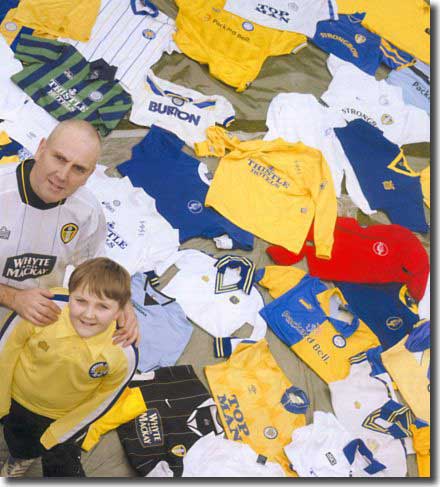 With
thanks to www.historicalkits.co.uk
- For a comprehensive look at all the kits click City
or United.
With
thanks to www.historicalkits.co.uk
- For a comprehensive look at all the kits click City
or United.
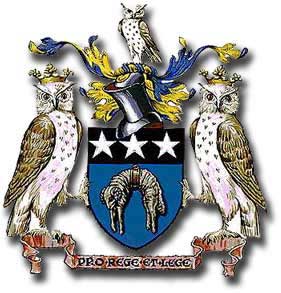 a
moniker that was passed down like a beloved inheritance to Leeds United
and stuck with the club long after the white became de rigueur.
a
moniker that was passed down like a beloved inheritance to Leeds United
and stuck with the club long after the white became de rigueur.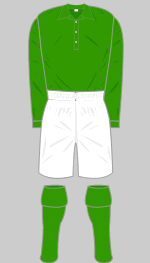
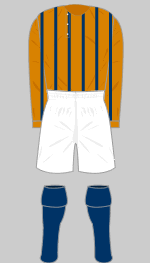
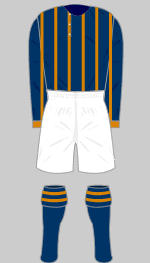
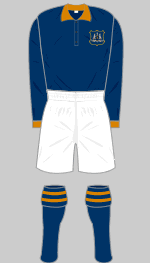 payments
led in 1885 to a decision by the FA to recognise professionalism and the
Football League was formed in 1888 to provide the leading clubs with regular
fixtures against the best sides.
payments
led in 1885 to a decision by the FA to recognise professionalism and the
Football League was formed in 1888 to provide the leading clubs with regular
fixtures against the best sides.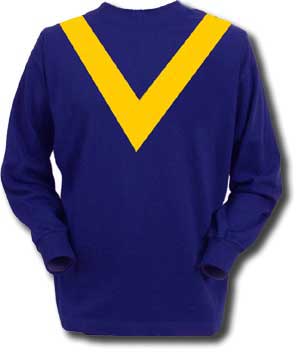 are
very young men, who have been brought into a higher class of football
than that to which they have been accustomed, and that they were playing
their first match amid unfamiliar surroundings. Mr Scott-Walford evidently
had an eye to making his new men feel at home as well as to stage effect
when he attired the team in green jerseys and supplied green flags to
mark the centre line.' They played in that kit throughout 1910/11.
are
very young men, who have been brought into a higher class of football
than that to which they have been accustomed, and that they were playing
their first match amid unfamiliar surroundings. Mr Scott-Walford evidently
had an eye to making his new men feel at home as well as to stage effect
when he attired the team in green jerseys and supplied green flags to
mark the centre line.' They played in that kit throughout 1910/11.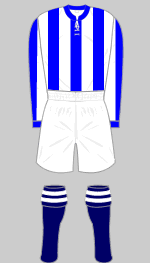 force
behind the early development of the new club and their election to the
League was Huddersfield Town chairman Hilton Crowther, who sought at first
to merge the two clubs. He eventually left the Terriers behind to take
over at Leeds United, bringing manager Arthur Fairclough with him. Their
history together at Leeds Road was echoed in the first fifteen years at
United as the club kit was modelled on Huddersfield's blue and white striped
shirts, in combination with white shorts and dark blue socks with blue
and white rings on the turnovers. The Terriers dominated English football
in the Twenties under the management of Herbert Chapman, winning their
first League championship in 1924, the same year United won the Second
Division title.
force
behind the early development of the new club and their election to the
League was Huddersfield Town chairman Hilton Crowther, who sought at first
to merge the two clubs. He eventually left the Terriers behind to take
over at Leeds United, bringing manager Arthur Fairclough with him. Their
history together at Leeds Road was echoed in the first fifteen years at
United as the club kit was modelled on Huddersfield's blue and white striped
shirts, in combination with white shorts and dark blue socks with blue
and white rings on the turnovers. The Terriers dominated English football
in the Twenties under the management of Herbert Chapman, winning their
first League championship in 1924, the same year United won the Second
Division title.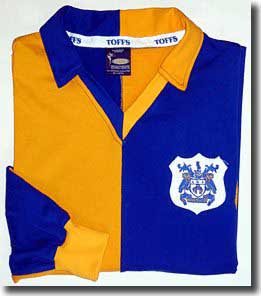 He
reluctantly followed their directive, but continued to use numbered shirts
for the reserves. Arsenal wore numbers at Highbury in December 1933 during
a friendly match with FC Vienna.
He
reluctantly followed their directive, but continued to use numbered shirts
for the reserves. Arsenal wore numbers at Highbury in December 1933 during
a friendly match with FC Vienna.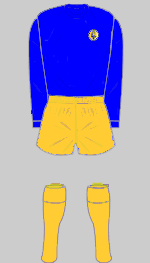
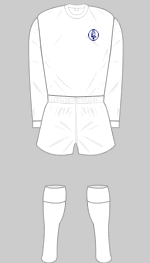
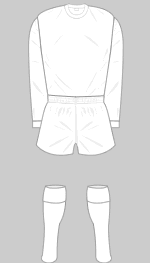
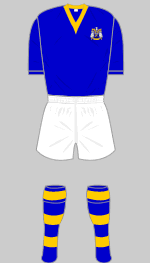
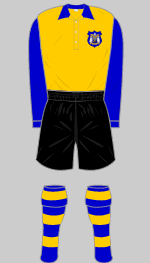 'It
might be supposed that technical advances in textile manufacture and dye
technology would have resulted in greater innovation in kit design. The
reverse was true: because of the increased use of floodlights, which allowed
midweek games to be played at night, many clubs adopted simplified designs
that would stand out more clearly under the lights (which were far less
effective than their modern counterparts). Liverpool were the first club
to adopt red shorts to match their shirts, while Chelsea quickly followed
suit with an all-blue ensemble.'
'It
might be supposed that technical advances in textile manufacture and dye
technology would have resulted in greater innovation in kit design. The
reverse was true: because of the increased use of floodlights, which allowed
midweek games to be played at night, many clubs adopted simplified designs
that would stand out more clearly under the lights (which were far less
effective than their modern counterparts). Liverpool were the first club
to adopt red shorts to match their shirts, while Chelsea quickly followed
suit with an all-blue ensemble.'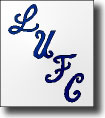
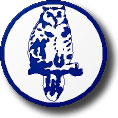 manager
by adding a broad white hoop to the Teessiders' all red shirts.
manager
by adding a broad white hoop to the Teessiders' all red shirts.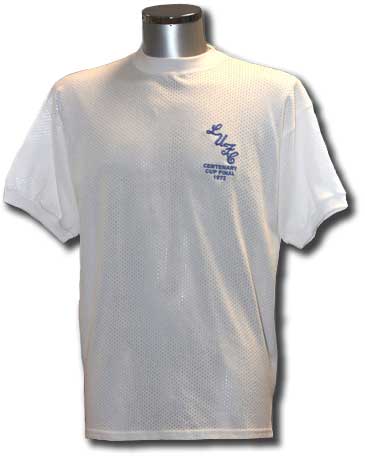 but
competition in Europe meant that for United there was a growing necessity
for an alternate strip when there was a clash of colours. For most of
the decade, Leeds generally opted for blue shirts coupled with gold shorts
and socks, but that made for a pretty unappetising combination. Phil Brown
reporting for the Yorkshire Evening Post on the FA Cup clash with West
Bromwich Albion in early 1967: 'Graham Williams, Albion's left-back, led
them out in all red, with a little boy mascot. United had also changed
- blue shirts, yellow shorts (ugh!)'
but
competition in Europe meant that for United there was a growing necessity
for an alternate strip when there was a clash of colours. For most of
the decade, Leeds generally opted for blue shirts coupled with gold shorts
and socks, but that made for a pretty unappetising combination. Phil Brown
reporting for the Yorkshire Evening Post on the FA Cup clash with West
Bromwich Albion in early 1967: 'Graham Williams, Albion's left-back, led
them out in all red, with a little boy mascot. United had also changed
- blue shirts, yellow shorts (ugh!)'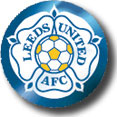
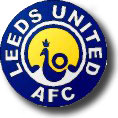
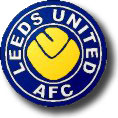
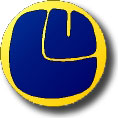
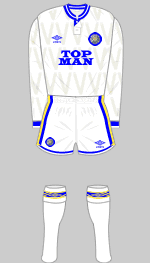
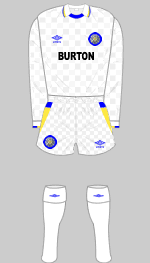
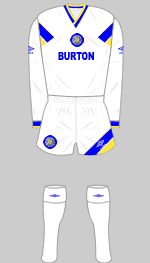
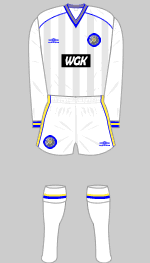
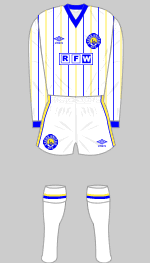
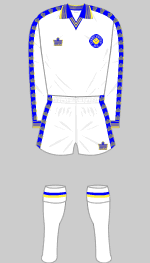 captured
significant sections of the market that now included selling replica kits
to fans. Admiral, who had done so much to transform kits in the previous
decade, overextended themselves and were bought up by Adidas, although
the brand re-emerged later in the decade.
captured
significant sections of the market that now included selling replica kits
to fans. Admiral, who had done so much to transform kits in the previous
decade, overextended themselves and were bought up by Adidas, although
the brand re-emerged later in the decade.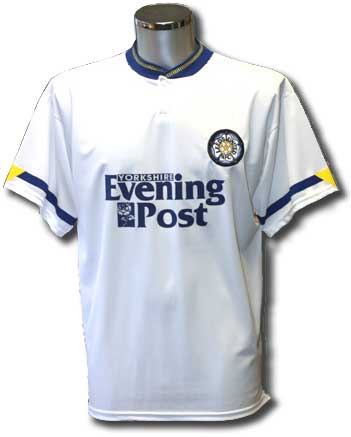 via sponsorship.
via sponsorship.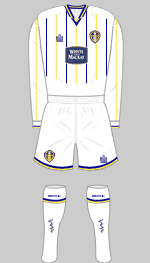
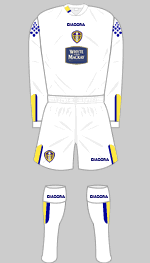
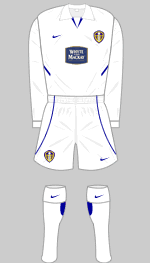
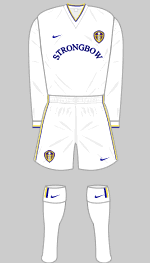
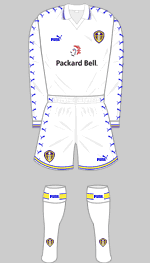
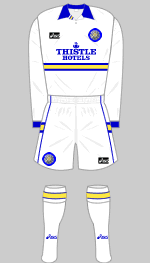 early
season run of goal getting - remember the beauties against Liverpool and
Wimbledon? Unhappily the season petered out after a promising start -
United made it to the League Cup final, although they couldn't compete
with Aston Villa and were hammered 3-0. The green and blue stripes were
dumped unceremoniously after an FA Cup tie at Bolton in 1996 with the
players complaining that the colours were too dark and made it difficult
to pick each other out. As a holding position, Asics introduced an all
yellow alternative.
early
season run of goal getting - remember the beauties against Liverpool and
Wimbledon? Unhappily the season petered out after a promising start -
United made it to the League Cup final, although they couldn't compete
with Aston Villa and were hammered 3-0. The green and blue stripes were
dumped unceremoniously after an FA Cup tie at Bolton in 1996 with the
players complaining that the colours were too dark and made it difficult
to pick each other out. As a holding position, Asics introduced an all
yellow alternative. introduced
part the way through the season as a sop to traditionalists.
introduced
part the way through the season as a sop to traditionalists.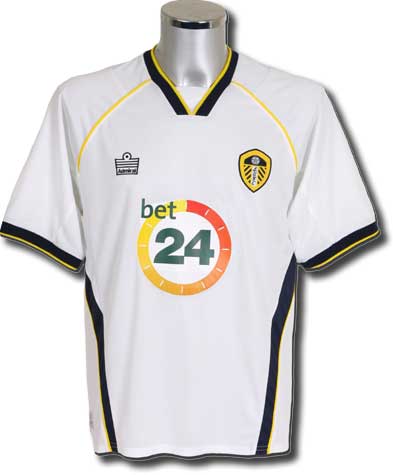 association
with United but had little to cheer about as Leeds slumped to disastrous
relegation in 2004. The logo was the only change to the home kit, but
a stylish dark blue outfit with yellow and white pinstripes was launched
for some away games. It was one of the unluckiest kits ever used by the
club - they gained a single point from the five games played in it, conceding
14 goals in the process. An all yellow kit was regularly used, and was
best remembered in a ripped and torn state, as modelled by the ill-fated
Roque Junior when he encountered Everton's Duncan Ferguson.
association
with United but had little to cheer about as Leeds slumped to disastrous
relegation in 2004. The logo was the only change to the home kit, but
a stylish dark blue outfit with yellow and white pinstripes was launched
for some away games. It was one of the unluckiest kits ever used by the
club - they gained a single point from the five games played in it, conceding
14 goals in the process. An all yellow kit was regularly used, and was
best remembered in a ripped and torn state, as modelled by the ill-fated
Roque Junior when he encountered Everton's Duncan Ferguson.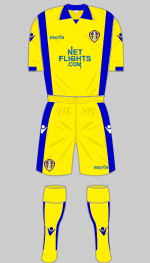
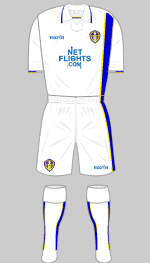
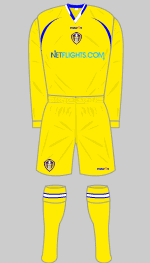
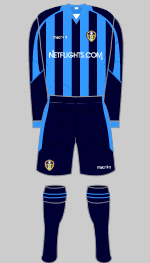
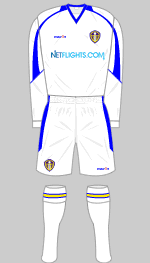
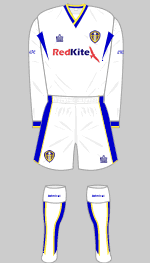 the
launch was spoiled by a dispute with their shirt sponsor, which delayed
delivery. In August a sponsorship deal was finalised with Netflights.com.
the
launch was spoiled by a dispute with their shirt sponsor, which delayed
delivery. In August a sponsorship deal was finalised with Netflights.com.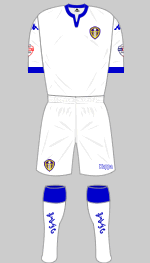
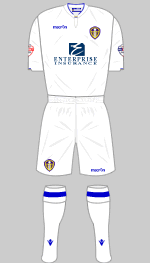
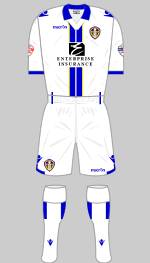
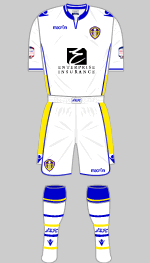
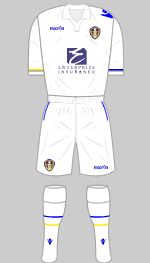
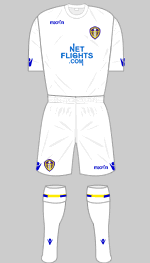 The
following day, the club's website carried the official news at the same
time as the identity of the new sponsors was revealed.
The
following day, the club's website carried the official news at the same
time as the identity of the new sponsors was revealed.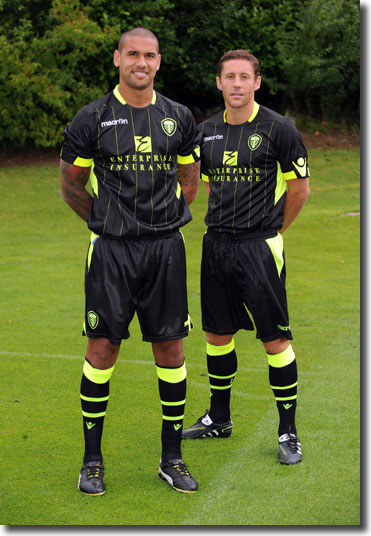 and
an even greater future. On a personal note, as a lifelong supporter of
Leeds, the deal has an added significance beyond the undoubted advantages
it will bring to both the club, and to us as a company. We are looking
forward to playing our part, together with the club management, the team,
and the supporters, in the continuing Leeds success story.'
and
an even greater future. On a personal note, as a lifelong supporter of
Leeds, the deal has an added significance beyond the undoubted advantages
it will bring to both the club, and to us as a company. We are looking
forward to playing our part, together with the club management, the team,
and the supporters, in the continuing Leeds success story.'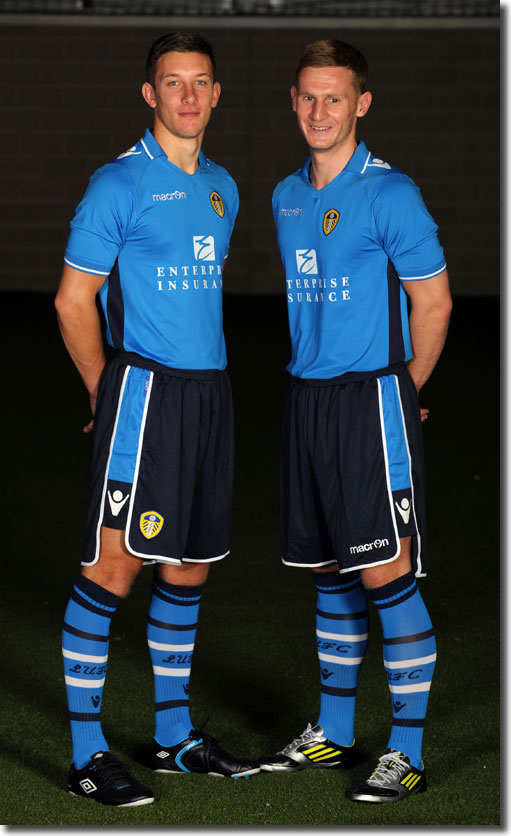 hackneyed,
but it was certainly stylish ...
hackneyed,
but it was certainly stylish ...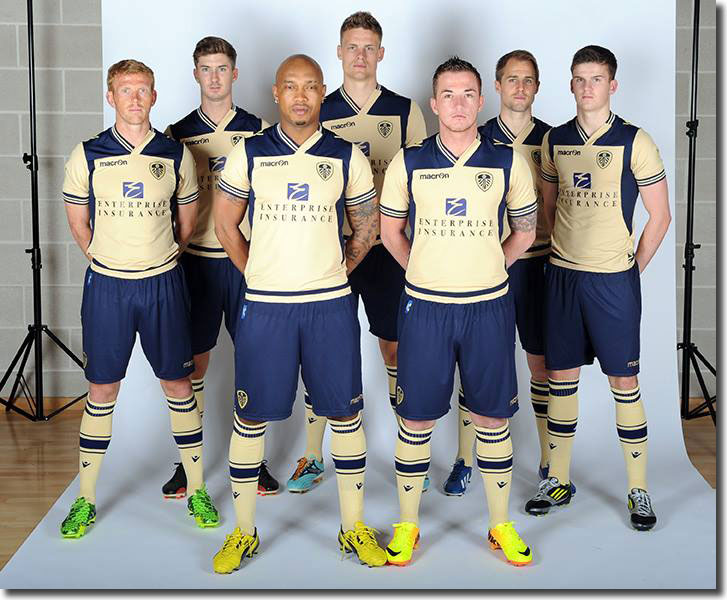 and
brand new Secondary Shirt Sponsor, Help-Link UK.'
and
brand new Secondary Shirt Sponsor, Help-Link UK.'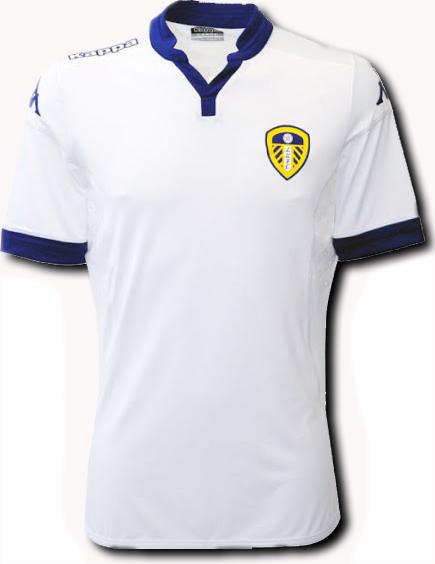 of
the kit for 2014/15 came far later than was customary, on 26 June
with the news coming from the club's official website, which reported:
of
the kit for 2014/15 came far later than was customary, on 26 June
with the news coming from the club's official website, which reported: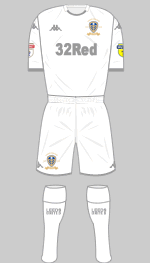
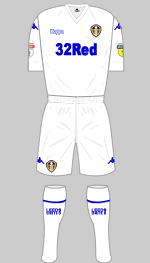
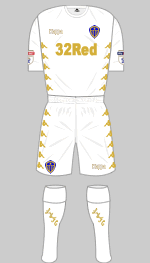
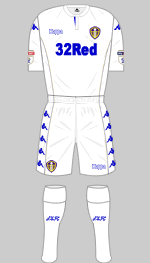
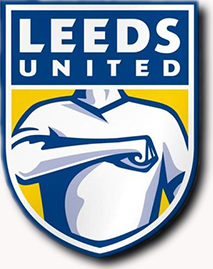 the club announced a new club crest to mark its centenary, but it was
greeted with universal derision.
the club announced a new club crest to mark its centenary, but it was
greeted with universal derision.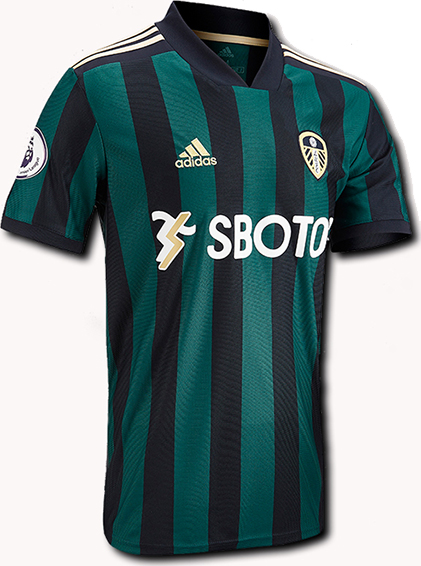
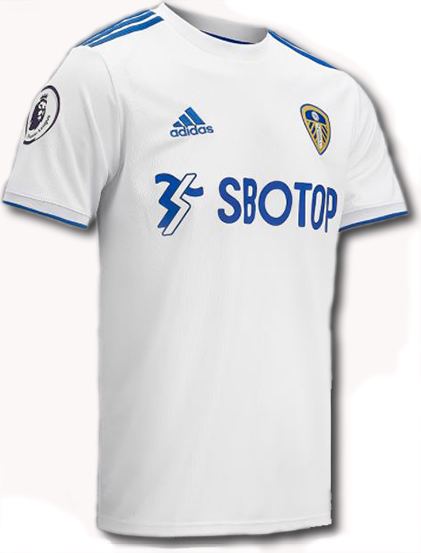 in
the next 100 years.'
in
the next 100 years.'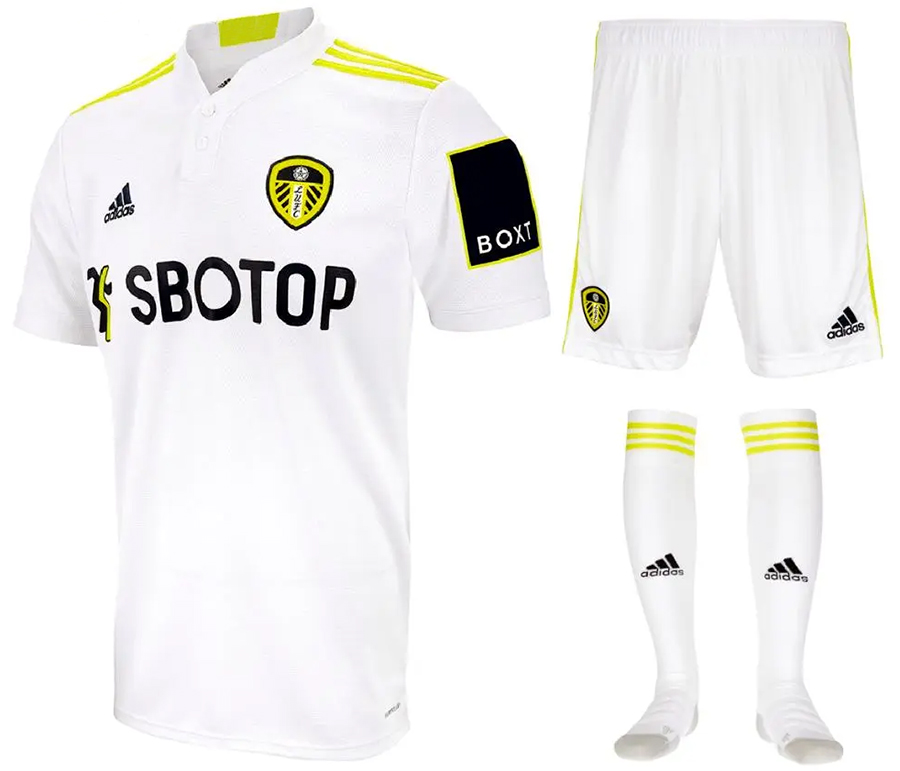 their peak and the kit is complete with traditional white shorts and socks.
So from the streets to the stands, no matter where the game takes you,
show your support for this one club city. Your Leeds United heroes will
wear the shirt with pride, returning to the top flight for the first time
in 16 years, each one a champion.'
their peak and the kit is complete with traditional white shorts and socks.
So from the streets to the stands, no matter where the game takes you,
show your support for this one club city. Your Leeds United heroes will
wear the shirt with pride, returning to the top flight for the first time
in 16 years, each one a champion.'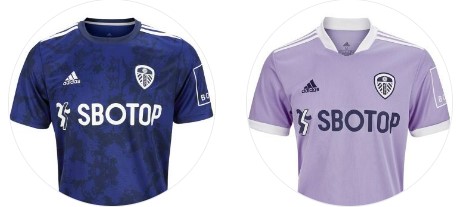 maroon sleeves and back, three gold stripes down the sides, a V-neck,
and gold band sleeve tipping. The shirt was tipped off with a woven tonal
maroon and gold crest.
maroon sleeves and back, three gold stripes down the sides, a V-neck,
and gold band sleeve tipping. The shirt was tipped off with a woven tonal
maroon and gold crest.
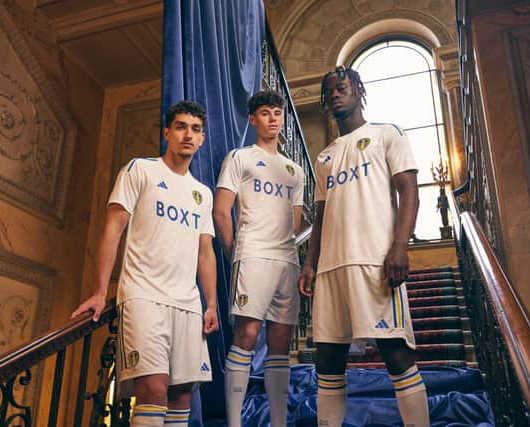 "pulse yellow" and "dark blue" strip ... The explosion
of pulse yellow blended with a dark blue for the shirt is a modern take
on some of our iconic yellow kits from the 70s and the colour coordinated
club crest sits proudly on the chest. The collar of the shirt is a classic
V-neck with a ribbed trim, with matching ribbed sleeve cuffs as you work
your way down the arm.' Do me a favour, chaps! Joe Donnohue wasn't joking
when he wrote in the Yorkshire Evening Post that it 'has already
divided opinion amongst supporters on social media who have expressed
both their delight and distaste of the new design'.
"pulse yellow" and "dark blue" strip ... The explosion
of pulse yellow blended with a dark blue for the shirt is a modern take
on some of our iconic yellow kits from the 70s and the colour coordinated
club crest sits proudly on the chest. The collar of the shirt is a classic
V-neck with a ribbed trim, with matching ribbed sleeve cuffs as you work
your way down the arm.' Do me a favour, chaps! Joe Donnohue wasn't joking
when he wrote in the Yorkshire Evening Post that it 'has already
divided opinion amongst supporters on social media who have expressed
both their delight and distaste of the new design'.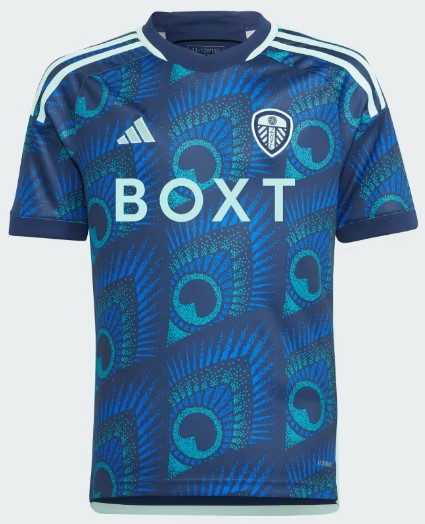 pattern
debossed throughout the fabric, and a peacock on the back neck,' chimed
the club's official blurb. 'The peacock holds a special place in Leeds
United and Elland Road history, with the peacock badge being worn in the
early 1980’s, a time when the club was affectionately known as the Peacocks.'
pattern
debossed throughout the fabric, and a peacock on the back neck,' chimed
the club's official blurb. 'The peacock holds a special place in Leeds
United and Elland Road history, with the peacock badge being worn in the
early 1980’s, a time when the club was affectionately known as the Peacocks.'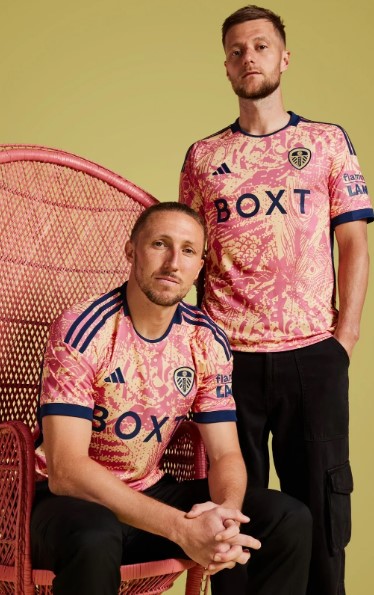 Adidas thought the Red Star concept was awesome. And it is now seen as
a cult classic. I saw online polls of the best kit of the year and it
was regularly in the top two or three. I learned how difficult the job
of designing a kit can be and the stress it involves.
Adidas thought the Red Star concept was awesome. And it is now seen as
a cult classic. I saw online polls of the best kit of the year and it
was regularly in the top two or three. I learned how difficult the job
of designing a kit can be and the stress it involves.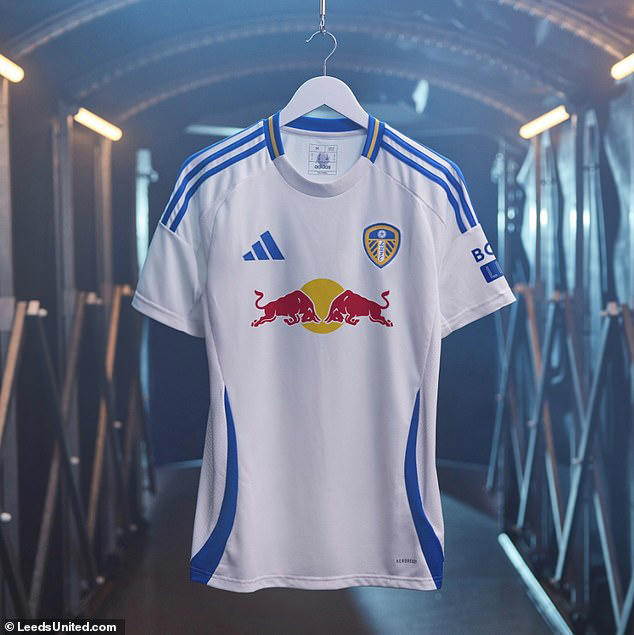 I
maybe had relative confidence in the home kit, this (the second and third
kits) is where you probably think more about what might happen, what the
reaction might be, what sort of lightning rod I might be.' For now, though,
the home shirt has struck a chord. And in a difficult post-relegation
summer with competitive challenges aplenty, it did Leeds no harm to register
a win with their kit design. Not long after it was released, Cowburn was
sent a photo of someone whose forearm had been tattooed with the peacock
feather design that features on the top. 'You know it's gone down well
when the pattern's being used for that,' he says.
I
maybe had relative confidence in the home kit, this (the second and third
kits) is where you probably think more about what might happen, what the
reaction might be, what sort of lightning rod I might be.' For now, though,
the home shirt has struck a chord. And in a difficult post-relegation
summer with competitive challenges aplenty, it did Leeds no harm to register
a win with their kit design. Not long after it was released, Cowburn was
sent a photo of someone whose forearm had been tattooed with the peacock
feather design that features on the top. 'You know it's gone down well
when the pattern's being used for that,' he says. 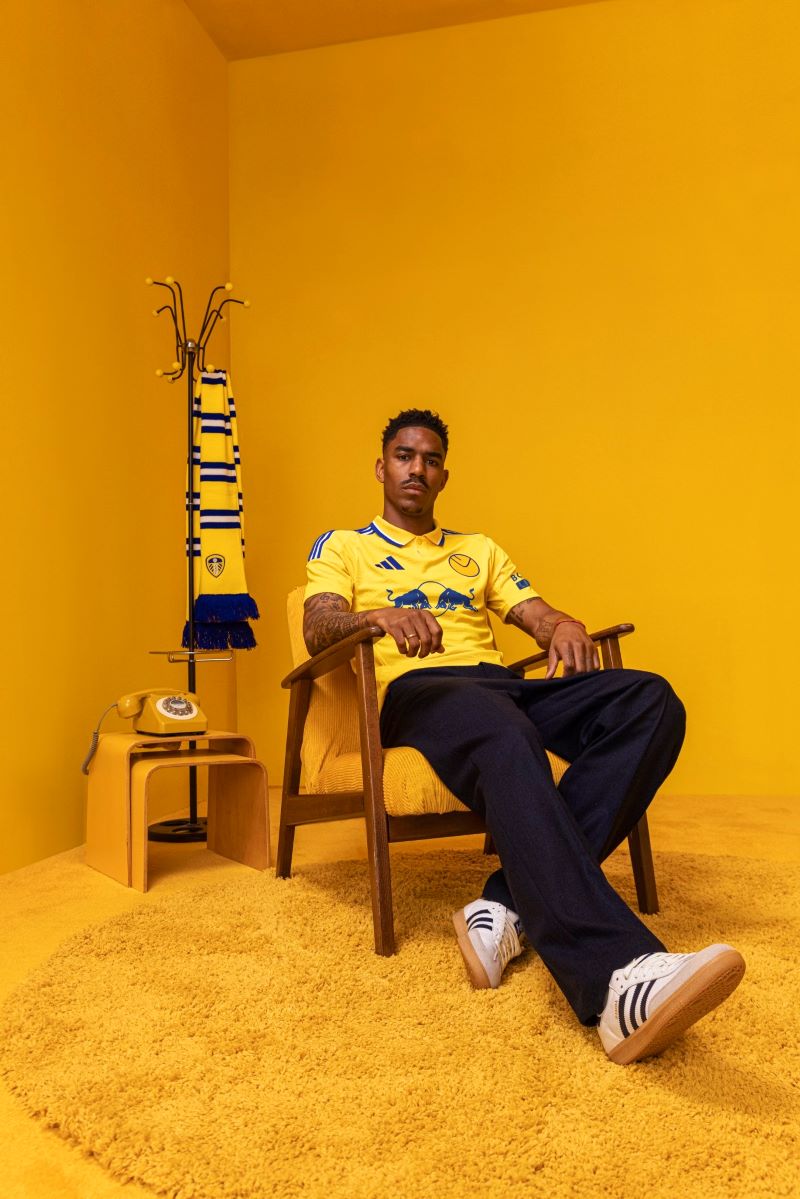 and
question everything.'
and
question everything.' 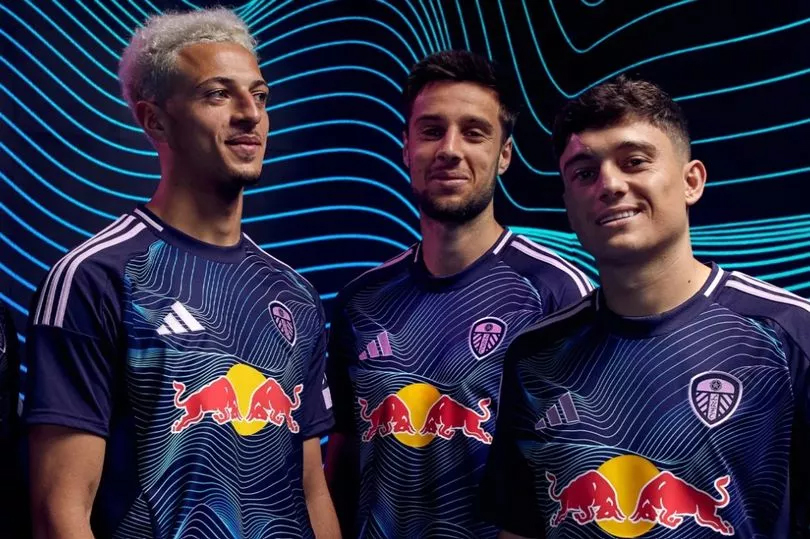 about
it.'
about
it.'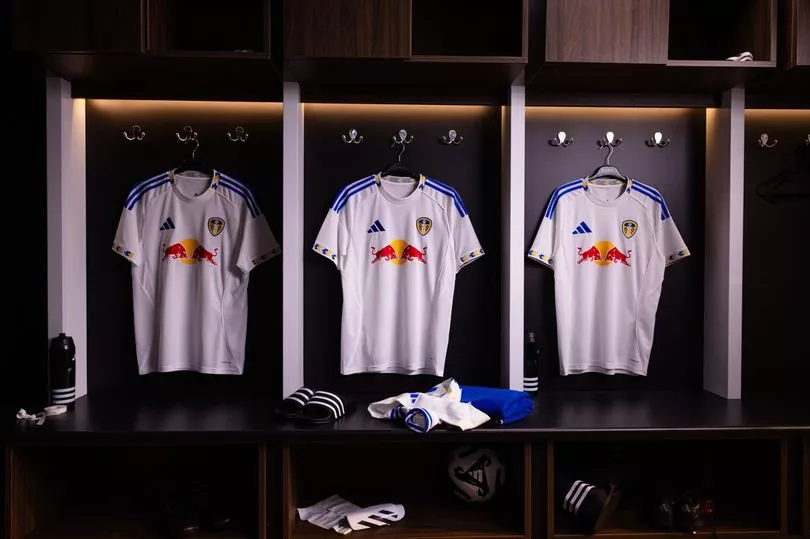 resilience, with the traditional white, blue and yellow colours across
the shirt, shorts, and socks, which is recognised around the world. This
classic aesthetic provides a clean and timeless foundation, allowing the
significant mosaic design elements to truly shine.
resilience, with the traditional white, blue and yellow colours across
the shirt, shorts, and socks, which is recognised around the world. This
classic aesthetic provides a clean and timeless foundation, allowing the
significant mosaic design elements to truly shine.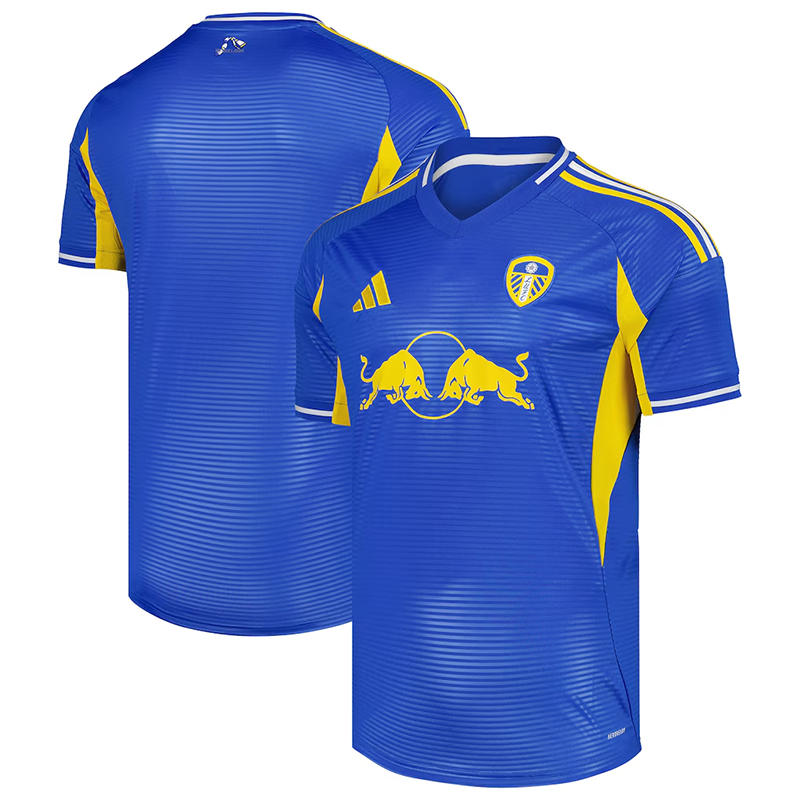 off
by vibrant yellow accents, an embossed tonal horizontal pattern across
the body, sewn crest, two-tone adidas stripes, and a 'WE ARE LEEDS' message
hidden inside the collar.
off
by vibrant yellow accents, an embossed tonal horizontal pattern across
the body, sewn crest, two-tone adidas stripes, and a 'WE ARE LEEDS' message
hidden inside the collar.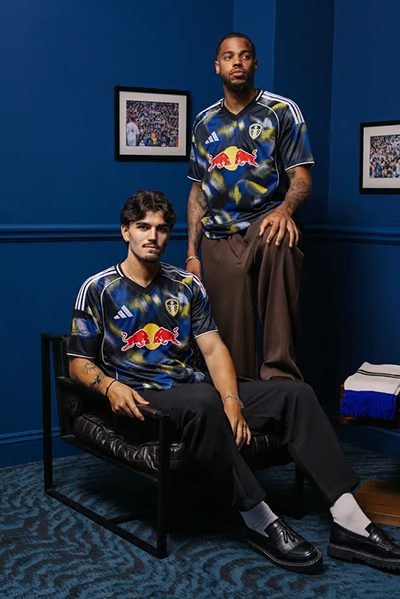 representing
the scarves often in view as fans sang 'we are the champions, champions
of Europe'.
representing
the scarves often in view as fans sang 'we are the champions, champions
of Europe'.